Portal:U.S. roads/Selected article
Previously selected articles of the U.S. Roads Portal. To nominate an article, follow the directions here.
2006
February

U.S. Route 66 was one of the original 1926 highways and was decommissioned in 1985 when it was completely bypassed by interstates. It is now designated an historic route for its entire length of 2,347 miles (3,777 km). Promoted as the "Main Street of America" and immortalized by John Steinbeck as the "Mother Road", it has been the subject of a television show, a popular song, and numerous books. It has also given its name to a gasoline company and two sports teams.
March

U.S. Route 1 (US 1) runs from Key West, Florida to Fort Kent, Maine for a total of 2,390 miles (3,846 km). Although it has the lowest number and should, in theory, be along the Atlantic Ocean, US 13 and US 17 at times are between US 1 and the ocean. The highway parallels the later Interstate 95 for much of its length and serves numerous cities along the east coast.
Recently selected: U.S. Route 66
April

The General Pulaski Skyway, commonly referred to as the Pulaski Skyway, is a series of cantilever truss bridges in New Jersey that carry four lanes of U.S. Highways 1 and 9 for 5.6 km (3.5 mi) between the far east side of Newark and Tonnelle Circle in Jersey City. It is considered by many to be the first "super highway" in the United States and is still in use in its original form.
Recently selected: U.S. Route 1 • U.S. Route 66
May

The Kansas Turnpike is a 236-mile (380 km) toll road entirely within the U.S. state of Kansas. The turnpike runs northeasterly from the Oklahoma border to the western fringes of the Kansas City metropolitan area. The Kansas Turnpike Authority (KTA), estimates that 120,000 drivers use the turnpike each day. The entire route is part of the Interstate system, although the Turnpike carries four different Interstate designations along its length.
Recently selected: Pulaski Skyway • U.S. Route 1 • U.S. Route 66
June

Interstate 95 (I-95) is an Interstate Highway that runs 1,927 miles (3,101 km) north–south along the east coast of the United States between Miami, Florida and Houlton, Maine. It is one of the best-known, most important, and most heavily travelled highways in the Interstate system. It serves and connects the major cities along the Northeast corridor, and it is the major north–south highway along the east coast. It is the longest north–south Interstate highway (five east–west routes are longer), and it passes through more states (15) than any other Interstate. As it passes through CT and RI, it actually runs east–west but still keeps its odd numeral designation. I-84 runs east–west through the same area, and parallels I-95, however has an even numeral designation.
Recently selected: Kansas Turnpike • Pulaski Skyway • U.S. Route 1
- Note: Was left as selected article until October.
November

New York State Route 104 (NY 104) is a 182-mile (293 km) long east–west highway in Upstate New York, USA. The entire length of the road was designated U.S. Route 104 (US 104) until 1972, except for locations near Rochester where the highway has since been moved onto expressways. NY 104 travels from NY 384 near the Rainbow Bridge in Niagara Falls in Niagara County to NY 13 near Altmar in Oswego County. Route 104 primarily runs parallel to the south shore of Lake Ontario throughout most of its route between the Niagara River in Niagara Falls and the Oswego River in Oswego.
Before US 104 was created, the roadway carried a number of designations, namely NY 3, 18 and NY 31. All three of these routes were reconfigured to allow for the designation of US 104.
Over time, the 104 designation has been shifted from surface streets to expressways and Super-2s, particularly from Rochester east to Oswego. The first such realignment occurred in the late 1940s in western Wayne County and was completed by the realignment of NY 104 onto the Irondequoit–Wayne County Expressway' near Webster in the early 1980s.
Recently selected: Interstate 95 • Kansas Turnpike • Pulaski Skyway
- Note: Was left as selected article until December.
2007
January

State Route 37 (SR 37) in the northern part of the U.S. State of California runs twenty-one miles along the northern shore of San Pablo Bay and is currently built from U.S. Route 101 in Novato, California to Interstate 80 in Vallejo, California. It serves as a crucial bypass around the northern end of the San Francisco Bay Area.
Recently selected: New York State Route 104 • Interstate 95 • Kansas Turnpike
February

Interstate 295 (I-295) in New Jersey and Delaware is a bypass route from a junction with Interstate 95 south of Wilmington, Delaware to another junction with I-95 north of Trenton, New Jersey. The route runs parallel with the New Jersey Turnpike for most of its course.
Interstate 295 is an auxiliary Interstate Highway, designated as a beltway around Philadelphia, Pennsylvania. Interstate 95 serves the city directly, connecting it with Wilmington and Trenton, whereas I-295 bypasses the city running east of the Delaware River. Interstate 95 was originally supposed to continue northeast from the routes' junction near Trenton on the proposed Somerset Freeway, but this plan was cancelled, limiting I-295's capability as a true bypass between Baltimore and New York City.
Today, traffic on Interstate 295 is directed to take Interstate 195 (or surface street connections further south) to the New Jersey Turnpike to reach New York City. The same route is prescribed for traffic on I-95 in Pennsylvania and near Trenton to bridge the gap with I-95 further north.
Recently selected: California State Route 37 • New York State Route 104 • Interstate 95
March

Interstate 290 (I-290) is a main Interstate freeway that runs west from the Chicago Loop. A portion of I-290 is officially called the Dwight D. Eisenhower Expressway. Colloquially it is known as the Eisenhower or the Ike. Before being designated the Eisenhower, the freeway was called the Congress Expressway for the surface street that was located approximately in its path and into which I-290 runs at its eastern terminus in the Loop.
Interstate 290 connects Interstate 90 (Northwest Tollway) in Rolling Meadows with Interstates 90/94 (Kennedy Expressway / Dan Ryan Expressway) near the Loop. North of Interstate 355, the freeway is known locally as Illinois Route 53, or simply Route 53, as Illinois 53 existed before Interstate 290, but now merges with I-290 at Biesterfield Road. In total, Interstate 290 is 29.84 miles (48.02 km) in length.
Recently selected: Interstate 295 (Delaware – New Jersey) • California State Route 37 • New York State Route 104
April

Interstate 476 (I-476) is a 132-mile (212 km) long Interstate Highway that travels between Interstate 95 near Chester, Pennsylvania and Interstate 81 near Scranton, Pennsylvania, serving as the primary north–south Interstate corridor through eastern Pennsylvania. It consists of both the approximately 21 miles (34 km) Mid-County Expressway (locally referred to as the Blue Route) through the suburban Philadelphia counties of Delaware and Montgomery, and the 110-mile (177 km) Northeast Extension of the Pennsylvania Turnpike connecting the Philadelphia metropolitan area with the Lehigh Valley, the Poconos, and the Scranton–Wilkes-Barre metropolitan area.
While proposed as early as 1929, the construction of the Mid-County Expressway through Delaware County, Pennsylvania was not completed until 1992 due to massive community and environmental opposition during the freeway revolts of the 1960s and 1970s, leading The Philadelphia Inquirer to dub it "the most costly, most bitterly opposed highway in Pennsylvania history."
Following the completion of the Mid-County Expressway, in 1996 the Interstate 476 designation was extended to include the entire length of the existing Northeast Extension, making I-476 the longest auxiliary Interstate highway in the United States.
Recently selected: Interstate 290 (Illinois) • Interstate 295 (Delaware – New Jersey) • California State Route 37
May

At 325 miles (523 km), U.S. Route 9's (US 9) New York segment accounts for more than half the highway's total length. It runs from the New Jersey state line in the middle of the George Washington Bridge to a cul-de-sac just south of the Canadian border north of Champlain. It is the longest north–south U.S. highway in the state.
The highway's passage through the state offers a diverse sample of New York to a traveler, taking in busy urban neighborhoods, suburban strips and forested wilderness. It is Broadway in Upper Manhattan and the Bronx. It uses parts of the old Albany Post Road in the Hudson Valley, where it passes the historic homes of a U.S. President and Gilded Age heir. It passes the center of New York political power in downtown Albany, and the patrician grandeur of Saratoga Springs. It penetrates into the deep recesses of the Adirondack Park and runs along the shore of Lake Champlain.
US 9 spawns more letter-suffixed state highways than any other route in New York, including the longest, 143-mile (230 km) NY 9N. Outside of the cities it passes through, it is a mostly a two-lane road, save for two expressway segments in the mid-Hudson region. For much of its southern half it follows the Hudson River closely; in the north it tracks Interstate 87, the Adirondack Northway.
Recently selected: Interstate 476 • Interstate 290 (Illinois) • Interstate 295 (Delaware – New Jersey)
June

State Route 1002 (SR 1002), locally known as Tilghman Street and Union Boulevard, is a major 13.7-mile (22.0 km) long east–west road in the Allentown–Bethlehem–Easton metropolitan area of the U.S. state of Pennsylvania. The majority of the roadway is the former alignment of U.S. Route 22, maintained by the Pennsylvania Department of Transportation as a Quadrant Route, and is not signed except on small white segment markers.
Tilghman Street begins at Pennsylvania Route 100 in Fogelsville, though SR 1002 continues west on Main Street (also old US 22) to the intersection of Church Street (SR 3014). It becomes Union Boulevard just east of the bridge over the Lehigh River in Allentown; SR 1002 ends at the interchange with Pennsylvania Route 378 in Bethlehem. Union Boulevard continues over Monocacy Creek, which forms the border between Lehigh and Northampton Counties, and ends in downtown Bethlehem.
Today, the highway attracts more than the average traffic for roads in the Lehigh Valley. An average of 21,018 vehicles use it in South Whitehall Township and 21,706 in Allentown each day.
Recently selected: U.S. Route 9 in New York • Interstate 476 • Interstate 290 (Illinois)
July

U.S. Route 40 (US 40) is an east–west United States highway. As with most routes whose numbers end in a zero, US 40 once traversed the entire United States. It is one of the original 1920s U.S. Highways, and its first designated termini were San Francisco, California, and Atlantic City, New Jersey. The western end has been truncated several times, and the route currently ends at I-80 just outside of Park City, Utah.
Starting at its western terminus in Utah, US 40 crosses a total of 12 states, including Colorado, Kansas, Missouri, Illinois, Indiana, Ohio, West Virginia, Pennsylvania, Maryland, Delaware, and New Jersey. One former and four current state capitals lie along the route. For much of its route, it runs parallel to or concurrently with three major Interstate Highways: I-70 from Empire, Colorado to Washington, Pennsylvania and again from Hancock to Baltimore, Maryland; I-68 along the Maryland Panhandle; and I-95 from Baltimore to New Castle, Delaware.
Recently selected: State Route 1002 (Lehigh County, Pennsylvania) • U.S. Route 9 in New York • Interstate 476
August

Pennsylvania Route 39 (PA 39) is a 17.68-mile (28.45 km) long, east–west state highway entirely within Dauphin County of the U.S. state of Pennsylvania. It is designated from North Front Street in Susquehanna Township, to U.S. Route 322 (US 322) and US 422 near Hershey.
From the western terminus to Interstate 81, PA 39 is known as Linglestown Road. Linglestown Road is mostly a two-lane road, signed east–west. From Interstate 81 to Hersheypark Drive, PA 39 is known as Hershey Road turning south, but keeping the east–west signage. Where the highway is named Hersheypark Drive', PA 39 is routed opposite to its alignment east of the eastern terminus.
Recently selected: U.S. Route 40 • State Route 1002 (Lehigh County, Pennsylvania) • U.S. Route 9 in New York
September
.svg.png.webp)
The portion of Interstate 15 in the U.S. state of Arizona passes through Mohave County in the far northwest corner of that state. Despite its short length of about 30 miles (48 km), and its isolation from the rest of the state in the remote Arizona Strip, it is notable for the scenic section through the Virgin River Gorge, the most expensive section of rural Interstate per mile when it opened.
Recently selected: Pennsylvania Route 39 • U.S. Route 40 • State Route 1002 (Lehigh County, Pennsylvania)
October

U.S. Route 50 (US 50) is a major east–west route of the U.S. Highway system, stretching just over 3,000 miles (4,800 km) from West Sacramento, California east to Ocean City, Maryland on the Atlantic Ocean. Until it was replaced by Interstate Highways west of Sacramento, it extended to San Francisco, near the Pacific Ocean. The route mostly remains separate from Interstates, and generally serves a corridor south of Interstates 70 and 80 and north of Interstate 64.
Signs at each end give the length as 3,073 miles (4,946 km), but the actual distance is slightly less, due to realignments since the former figure was measured.
Recently selected: Interstate 15 in Arizona • Pennsylvania Route 39 • U.S. Route 40
November

Within the U.S. state of New York, U.S. Route 15 extends 12.59 miles (20.26 km) through the Southern Tier from the New York–Pennsylvania border north to the western suburbs of Corning. The southern terminus is at the state line in Lindley, where US 15 continues into Pennsylvania. The northern terminus is at an interchange with Interstate 86, NY 15, and NY 17 in Painted Post northwest of downtown Corning.
US 15 originally continued north to Rochester before being truncated to its present northern terminus. Future plans call for US 15 to be redesignated as Interstate 99.
Recently selected: U.S. Route 50 • Interstate 15 in Arizona • Pennsylvania Route 39
December

New York State Route 9A (NY 9A) is a state highway in New York, United States, providing an alternate to U.S. Route 9 from New York City north to Peekskill. In New York City, it is a major route of its own, running along the West Side Highway and Henry Hudson Parkway. In Westchester County, NY 9A follows the Briarcliff–Peekskill Parkway.
Recently selected: U.S. Route 15 in New York • U.S. Route 50 • Interstate 15 in Arizona
2008
January

Interstate 355 (I-355), also known as the Veterans Memorial Tollway, is an interstate highway and tollway in the western and southwest suburbs of Chicago, Illinois, in the United States. Like other tollways in northeastern Illinois, it is run by the Illinois State Toll Highway Authority (ISTHA). I-355 runs from Interstate 80 in New Lenox north to Interstate 290 in Itasca, a distance of 32.5 miles (52.3 km). The highway is six lanes wide for its entire length.
Recently selected: New York State Route 9A • U.S. Route 15 in New York • U.S. Route 50
February

State Highway 74, usually abbreviated as SH-74 or OK-74 (or simply Highway 74) is the numbering of two different highways maintained by the U.S. state of Oklahoma. These highways were once a single major north–south route, connecting Oklahoma City to more rural parts of the state. The original road stretched from SH-7 near Tatums, Oklahoma to SH-11 west of Deer Creek.
Due to encroaching Interstate highways—especially Interstate 35—the middle section of the route through Norman, Moore, and Oklahoma City was decommissioned in 1979 for reasons of redundancy. However, some maps show SH-74 as concurrent with I-35, I-240, and I-44, thus linking the two sections.
Recently selected: Interstate 355 • New York State Route 9A • U.S. Route 15 in New York
March

In the U.S. state of Colorado, Interstate 70 is an Interstate Highway traversing an east–west route across the center of the state. The highway connects the metropolitan areas of Denver and Grand Junction via a route through the Rocky Mountains. The Colorado portion of I-70 is noted for the Eisenhower Tunnel. With an elevation of 11,158 feet (3,401 m) this tunnel was, at the time of construction, the highest vehicular tunnel in the world, and is the highest point along the Interstate Highway System. The Glenwood Canyon portion of the freeway is also noted as an engineering marvel. It is one of the last pieces of the Interstate Highway system to be completed on October 14, 1992. As of the date of its completion, this section had the most expensive construction cost per mile of any highway in the U.S. The construction achievement earned 30 awards for the Colorado Department of Transportation, including the 1993 Outstanding Civil Engineering Achievement Award from the American Society of Civil Engineers.
In addition to the engineering achievements required to construct the freeway, the construction unintentionally became noted as an event in the feminist movement. The Colorado portion of I-70 was built parallel to U.S. Route 40 east of Idaho Springs, Colorado. West of Idaho Springs I-70 was built along the corridor of a road that was numbered U.S. Route 6 at the time of I-70's construction.
Recently selected: Oklahoma State Highway 74 • Interstate 355 • New York State Route 9A
April 1 (April Fool's Day)

State Highway 251A, also known as SH-251A or OK-251A, is a highway maintained by the U.S. state of Oklahoma. It is 6 miles (9.7 km) long, running from State Highway 16 in Okay, Oklahoma to State Highway 80 north of Ft. Gibson. It runs across the dam of Fort Gibson Lake.
The reason for the number SH-251A is unclear, as there has never been a state highway in Oklahoma with the number 251. The highway was once part of SH-16.
Recently selected: Interstate 70 in Colorado • Oklahoma State Highway 74 • Interstate 355
April

U.S. Route 50 in Nevada crosses the center of Nevada and was designated the Loneliest Road in America by Life in July 1986. The name was intended as a pejorative, but instead, Nevada officials seized on it as a marketing slogan. The Nevada Commission on Tourism publishes novelty passports that visitors can validate at approved stops. Visitors can submit the completed passport for a certificate signed by the state governor to show they have "survived" the loneliest road. While route 50 may or may not be the loneliest road in America, its reputation for loneliness is merited. In the stretch of highway between Fallon and Delta, Utah, a span of 409 miles (658 km), there are only three major towns: Austin, Eureka and Ely.
The route follows a historic corridor, first used for the Pony Express, and later for the Lincoln Highway. The highway was first designated Nevada State Route 2. The highway passes through the center of the Great Basin and passes through a series of Basin and Range features in its path across the state. There are also several ghost towns along this path.
Recently selected: Interstate 70 in Colorado • Oklahoma State Highway 74 • Interstate 355
May

New York State Route 22 (NY 22) is a north–south state highway in New York paralleling the eastern edge of the state, from the outskirts of New York City to the Canadian border. At almost 341 miles (549 km) in total length, it is the longest north–south route in the state and currently the third longest overall, after NY 5 and NY 17. Many of the state's major east–west roads intersect with Route 22 just before crossing the state line into the neighboring New England states.
With the exception of its southern end, in the heavily-populated Bronx and lower Westchester County, as well as in the city of Plattsburgh near the northern end, almost all of Route 22 is a two-lane rural road that passes only through small villages and hamlets. The rural landscape off the road varies from horse country and views of the large reservoirs of the New York City watershed in the northern suburbs of city, to dairy farms further upstate in the hilly Taconics and Berkshires, to the undeveloped, heavily forested Adirondack Park along the shores of Lake Champlain. An 86-mile (138 km) section from Fort Ann to Keeseville is part of the All-American Road known as the Lakes to Locks Passage.
The southernmost section of the road used to be the White Plains Post Road in the 18th and 19th centuries, a major highway connecting New York City to White Plains, the county seat of Westchester County. Route 22 in its modern form was established in 1930 as one of the principal routes from New York City to Canada.
Recently selected: U.S. Route 50 in Nevada • Interstate 70 in Colorado • Oklahoma State Highway 74
June
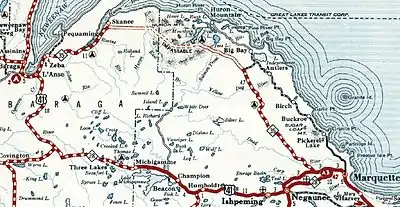
M-35 is a state trunkline highway in the Upper Peninsula (UP) of the U.S. state of Michigan. Running for 127.99 miles (205.98 km) in a general north–south direction, it connects the cities of Menominee, Escanaba and Negaunee. The southern section of M-35 in Menominee and Delta counties carries two additional designations. M-35 forms a segment of the Lake Michigan Circle Tour, and it is the UP Hidden Coast Recreational Heritage Trail, which is a part of the Michigan Heritage Routes system. Along the southern section, the highway is the closest trunkline to the Bay of Green Bay, a section of Lake Michigan, and is also the shortest route between Menominee and Escanaba. The northern section of the highway turns inland through wooded terrain, connecting rural portions of Delta and Marquette counties.
M-35 is an original state trunkline that was first designated by July 1 1919, originally intended to run from Menominee in the south to near Big Bay in the north, before turning toward L'Anse to end at Ontonagon. However, the section through the Huron Mountains in northern Marquette and Baraga counties was never built. Automobile pioneer Henry Ford helped halt this construction to gain favor with, and membership in, the exclusive Huron Mountain Club. Some discontinuous sections were later ceded to local control. The northern segment of the route between Ontonagon and Baraga was retained as a discontinuous segment of the highway; this northern segment was redesignated as another state trunkline. The northern end was rerouted out of the City of Negaunee into Negaunee Township to avoid mining activity near Palmer.
Recently selected: New York State Route 22 • U.S. Route 50 in Nevada • Interstate 70 in Colorado
July
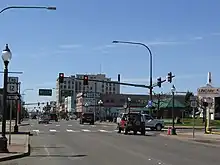
U.S. Route 12, (US 12), is a major east–west U.S. Highway, running from Aberdeen, Washington, to Detroit, Michigan. In the state of Washington, it runs for 403.80 miles (649.85 km), and is the only numbered highway to span the entire state from west to east, starting near the Pacific Ocean, and crossing the Idaho state line near Clarkston. It crosses the Cascade Range over White Pass, south of Mount Rainier National Park. Portions of it are concurrent with Interstate 5 (I-5) and Interstate 82 (I-82), although the majority of the route does not parallel any Interstate highway.
Although US 12 was not extended into Washington until 1967, portions of it have been part of Washington's state highway system since as early as 1905. The last part of the highway to open was over White Pass in 1951, although it was added to the state highway system by the legislature in 1931. Most of the route (except for the approximately 160 miles (260 km) between Elma and Naches) had been part of the U.S. Highway System since its inception in 1926 as part of US 410. The portion between Napavine and Grand Mound was also designated a U.S. Highway in 1926 as part of US 99.
Recently selected: Michigan M-35 • New York State Route 22 • U.S. Route 50 in Nevada
August
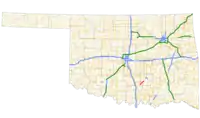
The Chickasaw Turnpike is a short two-lane toll road that is located in the rural south central region of the U.S. state of Oklahoma. It stretches for 17.3 miles (27.8 km) from west of Sulphur to just south of Ada. The Oklahoma Turnpike Authority (OTA) owns, maintains, and collects tolls on the turnpike. The first section of the Chickasaw Turnpike opened on September 1, 1991.
The Chickasaw resulted from a compromise between urban and rural legislators. Originally, it was part of a now-canceled plan to connect southern and eastern Oklahoma with a longer turnpike. It was also intended to link Ada to the Interstate system. OTA is negotiating an agreement to transfer all or part of it to the Oklahoma Department of Transportation (ODOT), making it a toll-free road.
Recently selected: U.S. Route 12 in Washington • Michigan M-35 • New York State Route 22
September

Utah State Route 128 (SR-128), is a state highway in the U.S. state of Utah. The entire length of the highway has been designated the Upper Colorado River Scenic Byway by the State of Utah. The highway also forms part of the Dinosaur Diamond Prehistoric Highway, a National Scenic Byway. The highway is commonly called the river road by residents of Moab, referring to the Colorado River, which the highway follows.
The highway was originally constructed by Grand County to connect rural cities in eastern Utah with Grand Junction, Colorado, the largest city in the region. The highway was partially absorbed into the state highway network in 1931, the rest was absorbed and assigned route number 128 in 1933.
The highway crosses the Colorado River at the site of the Dewey Bridge, listed on the National Register of Historic Places. This bridge was the longest suspension bridge in Utah until April 2008 when it was destroyed by a fire started by a child playing with matches. The future of the bridge is uncertain, with the county conducting a study to determine the feasibility of reconstructing it.
Recently selected: Chickasaw Turnpike • U.S. Route 12 in Washington • Michigan M-35
October

Vermont Route 17 (VT 17) is a 40.409-mile (65.032 km) long state highway in western Vermont. The western terminus is at the New York – Vermont state line on the Champlain Bridge in Chimney Point, where the route continues to New York State Route 9N/New York State Route 22 in Crown Point, New York, as New York State Route 910L, an unsigned reference route. The eastern terminus is at VT 100 in Waitsfield.
VT 17 was initially much shorter than it is today, encompassing only the Lake Champlain - Addison portion of its routing upon assignment. It was extended in the late 1960s through the Green Mountains to Waitsfield.
The routing of VT 17 varies greatly on opposite sides of the Bristol town center. West of Bristol, the route passes through generally level terrain and connects multiple communities. East of Bristol, VT 17 is more mountainous and more rural in nature.
Recently selected: Utah State Route 128 • Chickasaw Turnpike • U.S. Route 12 in Washington
November

Maryland Route 36 (MD 36, Route 36) is a 29.43 miles (47.36 km) state highway located in Allegany County, Maryland. MD 36 runs from the its southern terminus at the WV 46 bridge in Westernport to its northern terminus at U.S. Route 40 Alternate near Cumberland. Between Westernport and Frostburg, it is known as Georges Creek Road, and from Frostburg to Cumberland it is known as Mount Savage Road. Like the majority of Maryland state highways, MD 36 is maintained by the Maryland State Highway Administration (MDSHA).
MD 36 serves as the main road through the Georges Creek Valley, a region which is historically known for coal mining, and has been designated by MDSHA as part of the Coal Heritage Scenic Byway. MD 36 is the main road connecting the towns of Westernport, Lonaconing, and Midland in southwestern Allegany County, as well as Frostburg, Mount Savage, and Corriganville in northwestern Allegany County.
Recently selected: Vermont Route 17 • Utah State Route 128 • Chickasaw Turnpike
December
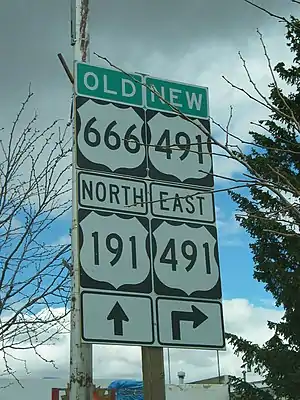
U.S. Route 491 (US 491) is a north–south U.S. Highway serving the Four Corners region of the United States. One of the newest designations in the U.S. Highway system, it was created in 2003 as a renumbering of US 666'. With the 666 designation, this road was nicknamed "Devil's Highway" because of the common Christian belief that 666 is the Number of the Beast. This satanic connotation, combined with a high fatality rate along the New Mexico portion, convinced some people the highway was cursed. The problem was compounded with chronic sign theft. These factors led to two efforts to renumber the highway, first by officials in Arizona, later in New Mexico. Since the renumbering, in conjunction with safety improvement projects, fatality rates have decreased.
The highway runs through Colorado, New Mexico and Utah, as well as the tribal nations of the Navajo Nation and Ute Mountain Ute Tribe. Features along the route include an extinct volcanic core named Shiprock, Mesa Verde National Park, and the self-proclaimed "pinto bean capital of the world". The route serves the states of New Mexico, Colorado and Utah. Before 1992, the highway also served Arizona. The Arizona portion was renumbered separately and is now part of US 191. The former US 666 was the only highway to have served all of the Four Corners states at the same time, even though it never came near the Four Corners Monument, accessed via US 160. At several points along US 491, mountain ranges in all of the Four Corners states are visible from a single location. The alignment of the highway is mostly north–south, however the Utah portion is signed east–west.
Recently selected: Maryland Route 36 • Vermont Route 17 • Utah State Route 128
2009
January
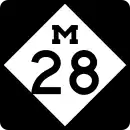
M-28 is an east–west state trunkline highway that almost completely traverses the Upper Peninsula in the U.S. state of Michigan, from Wakefield to near Sault Ste. Marie in Dafter Township. Along with US Highway 2 (US 2), M-28 forms a pair of primary highways linking the Upper Peninsula from end to end, providing a major access route for traffic from Michigan and Canada along the southern shore of Lake Superior. M-28 is the longest state trunkline in Michigan numbered with the "M-" prefix at 290.43 miles (467.40 km). The entire highway is listed on the National Highway System, while three sections of M-28 are part of the Lake Superior Circle Tour. M-28 also carries two memorial highway designations along its route.
Throughout its course across the Upper Peninsula, M-28 passes through forested woodlands, bog swamps, urbanized areas, and along the Lake Superior shoreline. Sections of roadway cross the Ottawa National Forest and both units of the Hiawatha National Forest. Some of the other landmarks accessible from M-28 include the Seney Stretch, Seney National Wildlife Refuge and several historic bridges.
Recently selected: U.S. Route 491 • Maryland Route 36 • Vermont Route 17
February

California State Route 78 (SR 78) is a state highway in the U.S. state of California that runs from Oceanside east to Blythe, traversing the entire width of the state. Its western terminus is at Interstate 5 (I-5) in San Diego County and its eastern terminus is at I-10 in Riverside County. The route travels as a freeway through the heavily populated cities of northern San Diego County before turning into a highway running through the Santa Rosa Mountains to Julian. Following this, SR 78 enters Imperial County and travels through the desert near the Salton Sea before turning north to Blythe.
SR 78 was one of the original state highways commissioned in 1934, although portions of the route existed as early as 1900. However, it was not commissioned east of Brawley until 1959. The freeway section in the North County of San Diego that connects Oceanside and Escondido has been improved several times, and there are many projects slated to improve the freeway due to increasing congestion in that region. An expressway bypass of the town of Brawley is also under construction.
Recently selected: Michigan M-28 • U.S. Route 491 • Maryland Route 36
March

New York State Route 28N (NY 28N) is a state highway in the Adirondacks in New York that extends from Blue Mountain Lake to North Creek. The route, 50.95 miles (82.00 km) in length, is a northerly alternate route to NY 28 between both locations. The highway passes through several communities before terminating at Route 28 in North Creek. Over its western end, it undergoes a 10-mile (16 km) concurrency with NY 30 through the town of (named after the lake) Long Lake, where Route 30 splits off, and Route 28N heads eastward through mountainous regions of the Adirondack Park.
The 40-mile (64 km) section of NY 28N not concurrent with NY 30 is designated as the Roosevelt–Marcy Trail, a scenic byway named for Theodore Roosevelt, who was then the Vice President of the United States. The byway marks the path Roosevelt took in 1901 to reach North Creek from Mount Marcy after learning that President William McKinley had been assassinated. The route has a rather scant history before its designations. The road originated as an old highway stretching from Warren County to Long Lake. It was used for transportation in the iron ore industry in Newcomb, and for the lumber industry in Minerva. New York State gained control of the road in 1909. The Route 28N designation was assigned as part of the 1930 renumbering, incorporating part of pre-1930 Route 10.
Recently selected: California State Route 78 • Michigan M-28 • U.S. Route 491
April 1 (April Fool's Day)

Interstate 238 (I-238) is a short auxiliary route of the Interstate Highway System in the San Francisco Bay Area, California, United States. Part of State Route 238 until 1983, and still considered the same route (part of Route 238) by the California Department of Transportation (Caltrans), it connects Interstate 580 in Castro Valley (where SR 238 continues south) with Interstate 880 in San Leandro. Despite running in an east–west direction, it is signed north–south, as the rest of Route 238 is more north–south than east–west.
The number does not follow established rules for numbering Interstates, as there is no Interstate 38. Of the nine possible numbers ending in 80 (as it connects two auxiliary routes of Interstate 80), two—180 and 480—were in use by State Routes (the latter an Interstate until 1968), and the seven others were used by other Interstates. (I-880 was designated at the same time as I-238; it too could only be an auxiliary route of I-80.)
Recently selected: New York State Route 28N • California State Route 78 • Michigan M-28
April

Interstate 68 (I-68) is a 112.6-mile (181.2 km) Interstate highway in the U.S. states of West Virginia and Maryland, connecting I-79 in Morgantown to I-70 in Hancock. I-68 is also Corridor E of the Appalachian Development Highway System and, prior to its completion in 1991, was designated as U.S. Route 48 (US 48). In Maryland, the highway is known as the National Freeway, an homage to the historic National Road, which I-68 parallels between Keysers Ridge and Hancock. The region spanned by the freeway is largely rural and mountainous, with I-68 crossing numerous mountain ridges along its route. I-68 is noted for the road cut constructed for it through Sideling Hill which exposed geological features of the mountain and has become a tourist attraction.
Recently selected: New York State Route 28N • California State Route 78 • Michigan M-28
May

U.S. Highway 41 (US 41) is a part of the U.S. Highway System that runs from Miami, Florida to the Upper Peninsula of Michigan (UP). In the U.S. state of Michigan, it is a state trunkline highway that enters the state via the Interstate Bridge between Marinette, Wisconsin and Menominee, Michigan. Along its 279.167-mile (449.276 km) route in the state, US 41 serves as a major conduit for Michigan traffic. Most of the highway is listed on the National Highway System. Along the routing, various sections are rural two-lane highway, urbanized four-lane divided expressway and the Copper Country Trail National Scenic Byway. The northernmost community along the highway is Copper Harbor at the tip of the Keweenaw Peninsula. The trunkline ends at a cul-de-sac east of Fort Wilkins State Park after serving the Central UP and Copper Country regions of Michigan.
Along the route, US 41 passes through farm fields, forest lands, and along the Lake Superior shoreline. The highway is included in the Lake Superior Circle Tour and the Lake Michigan Circle Tour and also passes through the Hiawatha National Forest and the Keweenaw National Historical Park. Historical landmarks along the trunkline include the Marquette Branch Prison, Peshekee River Bridge and the Quincy Mine. The highway is known for a number of historic bridges including a lift bridge and a bridge called "one of Michigan's most important vehicular bridges" by the Michigan Department of Transportation. Seven different memorial highway designations have been applied to parts of the trunkline since 1917, including one named for a Civil War general.
US 41 was an original US Highway first designated in 1926. It replaced the original M-15 designation of the highway, which ran from Menominee to Marquette, Houghton and ended in Copper Harbor. M-15 was a part of the original trunkline system. Realignments and construction projects have expanded the highway to four lanes in Delta and Marquette counties. These changes also created three business loops off the main highway.
Recently selected: Interstate 68 • New York State Route 28N • California State Route 78
June

Pennsylvania Route 652, designated by the Pennsylvania Department of Transportation (PennDOT) as State Route 0652, is a 10.57-mile (17.01 km) long east–west state highway located in the northeast Pennsylvania county of Wayne. The western terminus of the route is at U.S. Route 6 (US 6) in the Texas Township community of Indian Orchard. The highways heads to the northeast, and reaches the eastern terminus at the New York–Pennsylvania border in Damascus Township, where Route 652 crosses the Narrowsburg–Darbytown Bridge over the Delaware River and into New York, continuing as New York State Route 52 and Sullivan County Route 24.
The highway originated as the easternmost stretch of US 106 when the United States Highway System was first put together in 1926. The route, however, was assigned as a state highway in 1920. Route 652 was once used south of the alignment, in the northern suburbs in Philadelphia. Route 652 remained on that alignment until 1946, and in 1972, the 652 designation was reassigned onto US 106 alignment.
Recently selected: U.S. Route 41 in Michigan • Interstate 68 • New York State Route 28N
July

State Route 531 (SR 531) is a short Washington state highway in Snohomish County. It extends east 9.88 miles (15.90 km), from Wenberg State Park in the community of Lake Goodwin, to SR 9 in southeast Arlington. SR 531 intersects Interstate 5 (I-5), and passes the Arlington Airport. The route connects I-5 to SR 9, Smokey Point, and Wenberg State Park. The Washington State Legislature approved SR 531's current route in 1991. Since then, construction projects, arranged by the Washington State Department of Transportation (WSDOT), have turned this small road into an arterial street. Even though the Washington State Legislature and WSDOT approved SR 531 in 1991, they erected no signs until April 1, 1992, when the law creating the road took effect.
The road now used by SR 531 has existed as a separate route since at least 1911. A map dating from 1911 shows that 172nd Street, then known simply as Lakewood Road and Edgecomb Road, extended east from its current intersection with SR 9 to the banks of the South Fork Stillaguamish River. In October 2008, WSDOT discovered a collapsed culvert on SR 531's Cougar Creek bridge. They repaired the culvert using a hydraulic ram to insert a 24-inch (610 mm) diameter pipe to stabilize it. The construction, which took place on October 21 and October 24, caused traffic on SR 531 to detour to McRae Road, 45 Road, and 11th Avenue.
Recently selected: Pennsylvania Route 652 • U.S. Route 41 in Michigan • Interstate 68
August
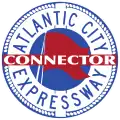
The Atlantic City – Brigantine Connector, also known as the Atlantic City Expressway Connector or simply the Brigantine Connector, is a highway connector in Atlantic City, New Jersey. It connects the Atlantic City Expressway with Route 87, which leads into Brigantine, a beach resort along the Atlantic Ocean. The connector is 2.5 miles (4.0 km) long and is maintained by the South Jersey Transportation Authority. It is considered to be a state highway and is assigned the route number Route 446X; however, the route number is not displayed among any of the road's signage. The connector consists of lettered exits from A to I in south to north order and features 10 bridges and 15 ramps throughout its length.
The Atlantic City – Brigantine Connector was initially planned in 1995 to provide a direct connection between the Atlantic City Expressway and the Brigantine area. Construction of the road was completed in 2001 at a total cost of $330 million (equivalent to $545 million in 2023). Before the Atlantic City – Brigantine Connector was planned, Mirage Resorts president Steve Wynn acquired a piece of land near the northern end of the proposed connector and planned for a direct exit ramp to a proposed casino called Le Jardin. Donald Trump, the chief executive officer of Trump Organization, who owned the nearby Trump Marina, took legal action against the state for the proposed ramp to Wynn’s casino. Despite the legal concerns, construction on the connector began in 1998. Wynn’s proposed casino was canceled following the acquisition of Mirage Resorts by MGM Grand Inc., which, as the MGM Mirage company, proposed the Borgata casino. Meanwhile, Trump’s casino received a direct ramp from the connector.
Recently selected: Washington State Route 531 • Pennsylvania Route 652 • U.S. Route 41 in Michigan
September

The Ridge Route, officially the Castaic–Tejon Route, is a narrow two-lane highway in the northern Greater Los Angeles Area of the U.S. state of California. Opened in 1915 and paved with concrete from 1917 to 1921, the road was the first paved highway directly linking the Los Angeles Basin with the San Joaquin Valley over the Tejon Pass and the rugged ridge south of Gorman; it was particularly used to travel from the city of Los Angeles to and beyond Bakersfield. Most of the road was bypassed in 1933 by the Ridge Route Alternate (then U.S. Route 99), which has since been upgraded to a modern freeway (Interstate 5). The portion of the old road within the Angeles National Forest was added to the National Register of Historic Places in 1997, and is temporarily closed pending repairs; the other remnants of the original two-lane road not destroyed by later construction are used by local traffic.
Recently selected: Atlantic City – Brigantine Connector • Washington State Route 531 • Pennsylvania Route 652
October

Interstate 37 (I-37) is a 143.0-mile (230.1 km) intrastate Interstate Highway located within the U.S. state of Texas. The highway was first designated in 1959 as a route between Corpus Christi and San Antonio. Construction in the urban areas of Corpus Christi and San Antonio began in the 1960s and the segments of the Interstate Highway in rural areas were completed by the 1980s. Prior to I-37, the route between Corpus Christi and San Antonio was served by a combination of State Highway 9 (SH 9) from Corpus Christi to Three Rivers and U.S. Highway 281 (US 281) from Three Rivers to San Antonio. As a result of the construction of I-37, SH 9 was removed from the State Highway System.
The highway's southern terminus is located in Corpus Christi at US 181 and SH 35, and heads north to San Antonio, where it ends at I-35. The freeway continues as US 281 beyond I-35 to northern San Antonio as a major freeway. In Corpus Christi, the highway provides access to the downtown area, the Port of Corpus Christi and the Corpus Christi International Airport. In San Antonio, it provides access to downtown, Brooks City-Base, the Alamodome, the Tower of the Americas, the River Walk, the Alamo, and by extension via US 281, the San Antonio International Airport. The route provides an important connection between I-35 and the Texas Gulf Coast as well as one of the few limited-access hurricane evacuation routes away from the southern Texas coast.
Recently selected: Ridge Route • Atlantic City – Brigantine Connector • Washington State Route 531
November

U.S. Route 5 (US 5), a north–south U.S. Highway that is generally paralleled by Interstate 91 (I-91), begins at the city of New Haven in Connecticut and heads north through western Massachusetts and eastern Vermont to the international border with Canada. Within Connecticut, US 5 proceeds north from New Haven and passes through Meriden and Hartford towards Springfield, Massachusetts.
US 5 roughly follows the route used by the Upper Boston Post Road, an early colonial highway for transporting mail between New York City and Boston. The route was first improved in 1798 as the Hartford and New Haven Turnpike, which ran in a nearly straight line between the court houses of New Haven and Hartford. In 1922, the Upper Boston Post Road corridor was designated as Route 2 of the New England road marking system, crossing to the east of the Connecticut River in Hartford before continuing north to the Massachusetts state line. In 1926, Route 2 was redesignated as US 5. Several realignments have been made in the cities of New Haven and Hartford with the opening of several expressways in these areas. Because it is closely paralleled by I-91 between New Haven and Hartford, US 5 serves mainly as a secondary route today.
Recently selected: Interstate 37 • Ridge Route • Atlantic City – Brigantine Connector
December

Route 99, also known as the Woonsocket Industrial Highway, is a numbered state highway running 2.9 miles (4.7 km) in Providence County, Rhode Island, United States. The route is a nominally north–south limited-access freeway for its entire length. Route 99 serves Manville and the Highland Industrial Park, providing freeway access to the city of Woonsocket from Rhode Island Route 146, which bypasses the city. The southern terminus of Route 99 is at a partial interchange with Route 146 in Lincoln. The freeway has one unnumbered interchange in Manville, a village in Lincoln, before terminating at an at-grade intersection with Route 122 in Woonsocket.
Originally conceived as a freeway linking Route 146 and Interstate 295 with Interstate 495 in Bellingham, Massachusetts, Route 99 was constructed primarily to provide freeway access to Woonsocket and the developing Highland Industrial Park. Although originally proposed to serve Downtown Woonsocket, an alternate routing that terminated at Route 122 and ran closer to the Woonsocket–Cumberland border was later constructed by the Rhode Island Department of Transportation (RIDOT). The four-lane freeway began construction in 1987 and was completed in 1993. RIDOT has long-range plans to extend Route 99 north to Route 114 in Downtown Woonsocket, but plans for a northerly extension to I-495 have been abandoned.
Recently selected: U.S. Route 5 in Connecticut • Interstate 37 • Ridge Route
2010
January

State Route 37 (SR 37) is a primary state highway in the U.S. state of Virginia. It forms a western bypass of Winchester, connecting to Interstate 81 (I-81) at both ends. Although the road is a freeway, neither I-81 connection is freeway standard; the south end (exit 310) is a diamond interchange with two traffic signals, while, at the north end, drivers must use a short piece of U.S. Route 11 (US 11) to connect with I-81 at exit 317. In addition to local access, the highway connects to US 50 and US 522, two major highways that lead west and northwest into West Virginia and north to Interstate 70 at Hancock, Maryland. An eastern bypass, known locally as "Route 37 East", has been proposed in statewide and local plans to complete the loop.
Recently selected: Rhode Island Route 99 • U.S. Route 5 in Connecticut • Interstate 37
February
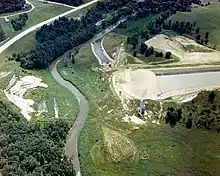
State Trunk Highway 131 (often called Highway 131, STH 131 or WIS 131) is a 79.0-mile (127.1 km) state highway in the U.S. state of Wisconsin. The highway is located in Wisconsin's Driftless Area, and it passes through Crawford, Vernon, Richland, and Monroe counties. It runs from WIS 60 near Wauzeka north to U.S. Highway 12 (US 12) and WIS 16 in Tomah. WIS 131 is maintained by the Wisconsin Department of Transportation (WisDOT).
WIS 131 was designated in 1923 on a road between Ferryville and Gays Mills. It was realigned and several times in the next fifteen years, and it ultimately connected Wauzeka and Tomah in 1948. The highway was rerouted in northern Vernon County in the 1970s in expectation of a new dam on the Kickapoo River; however, when the dam project stalled in 1975, part of the rerouting between Rockton and Ontario was put on hold as well. WisDOT consequently performed very little maintenance on this section of WIS 131 for two decades after the dam project stopped, and it fell into disrepair. The state ultimately rebuilt the highway in the early 2000s, and the refurbished highway opened in 2003.
Recently selected: Virginia State Route 37 • Rhode Island Route 99 • U.S. Route 5 in Connecticut
March
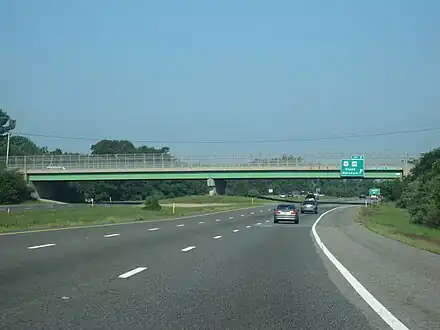
Route 25 is a numbered state highway located in Plymouth County and Barnstable County, Massachusetts, United States. The route is a nominally east–west freeway for its entire length. An eastward continuation of Interstate 495 (I-495), Route 25 provides freeway access to Cape Cod. The route's western terminus is at a trumpet interchange with I-495 and I-195 in Wareham. The route has three numbered interchanges along its 10.0-mile (16.1 km) length before terminating at the northern end of the Bourne Bridge in Bourne; the mainline of Route 25 continues across the bridge and over the Cape Cod Canal as Route 28 south.
Prior to 1982, the Route 25 designation was also given to a segment of what is now I-495 from Raynham to the interchange with I-195 in Wareham. The freeway was redesignated as I-495 in various stages during the 1970s and 1980s, eventually reducing Route 25 to a 2.5-mile (4 km) segment that continued eastward from I-495 to the modern location of Exit 2 in Downtown Wareham. Construction of an eastern continuation of Route 25 to the Bourne Bridge was delayed for nearly three decades due to property disputes and environmental concerns, but the final 7.5-mile (12 km) segment opened in 1987. The freeway was originally planned to continue over the Bourne Bridge into Cape Cod, but this plan was abandoned by the Massachusetts Highway Department in the late 1970s.
Recently selected: Wisconsin Highway 131 • Virginia State Route 37 • Rhode Island Route 99
April 1 (April Fool's Day)

U.S. Route 491 is a much maligned north–south U.S. Highway. The inspiration for such timeless classics as Natural Born Killers and AC/DC's Highway to Hell, the highway was perhaps best described by the USA Today with the headline "Everyone dies on that highway." The highway is so hated its signs are frequently attacked with chainsaws, by people crashing their cars into the signposts and the occasional volcano. The highway has made rural Utah a haven for potheads and devil worshipers, and is proof the state is so backwards, even the mileposts run in the opposite direction. The hatred is so intense two of the United States, Arizona and New Mexico, have outlawed the highway, with the latter having gone so far as completely ripping up the pavement and starting again. In fact, the only people who seem to actually like the road is eBay, where signs are known to fetch a premium.
Recently selected: Massachusetts Route 25 • Wisconsin Highway 131 • Virginia State Route 37
April
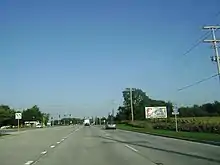
Illinois Route 22, also known as Half Day Road for part of its length, is an east–west state highway in northeastern Illinois. It runs from U.S. Route 14 (US 14, Northwest Highway) in Fox River Grove to US 41 (Skokie Highway) in Highland Park. It travels a distance of 19.7 miles (31.7 km) and is one of the few roads that runs almost entirely across southern Lake County while also providing access to southeastern McHenry County. Throughout its length, it shifts between two and four lanes as it passes through a frequently changing setting of scenic forestry and smaller populations, as well as busy intersections and larger developments.
It originally started as State Bond Issue Route 22, a massive loop around the Chicago area in 1918, similar to the path of the modern Interstate 294. The roadway was later shortened in 1935, and it has retained its current, much shorter route ever since 1937. During the 1990s, it became the subject of much concern for local residents regarding expansion which slowed down any progress for capacity improvement. By the late 2000s, the delays have come and gone and it has emerged as a state route that has been largely modernized to deal with heavy traffic. Recent construction projects have rebuilt the Route 22 bridge over the Tri-State Tollway to accommodate a widening of the latter, while future improvements are planned that would widen the remaining two-lane sections to four lanes.
Recently selected: Massachusetts Route 25 • Wisconsin Highway 131 • Virginia State Route 37
May
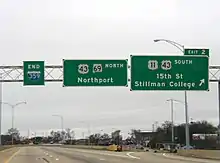
Interstate 359 (I-359) is a part of the Interstate Highway System in the US state of Alabama. It is a spur route that runs for 2.76 miles (4.44 km) entirely within the city limits of Tuscaloosa. Its termini are just south of I-20/I-59 interchange on the south side of town and U.S. Highway 43 (US 43) in downtown Tuscaloosa. The entire length is concurrent with U.S. Highway 11 (US 11) and Alabama State Route 69 (SR 69), with both continuing as at-grade thoroughfares north and south of the shorter Interstate.
In the early 1960s, local planners and elected officials stated the need for direct access to Interstate 59 from the city of Tuscaloosa. As annexation had not yet brought the city limits to the I-59 corridor, Interstate 359 was originally to be the only access provided to I-59 directly from Tuscaloosa. The route as originally envisioned, was to have has no exits for the duration of its route between its southern terminus at I-59 and its northern terminus at 15th Street in downtown Tuscaloosa. Actual planning for I-359 commenced in 1961. Planning for the corridor continued throughout the 1970s, only to stall briefly due to complications with the required environmental impact assessment associated with the project. Construction would commence in 1980 on the first phase of the freeway, and the first segment of I-359 opened to traffic in October 1982 between I-20/59 and Exit 1. The freeway was officially dedicated and opened for traffic on September 13, 1983.
Recently selected: Illinois Route 22 • Massachusetts Route 25 • Wisconsin Highway 131
June
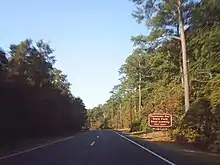
U.S. Route 113 (US 113) is a spur of U.S. Route 13 in the U.S. states of Maryland and Delaware. The highway runs 74.75 mi (120.30 km) from US 13 in Pocomoke City, Maryland north to Delaware Route 1 (DE 1) in Milford, Delaware. US 113 is the primary highway within Worcester County, Maryland, connecting the county's three population centers of Pocomoke City, Snow Hill, and Berlin. The highway also provides access to Ocean City via its connections with US 50 and Maryland Route 90. US 113 is one of three major north–south highways in Sussex County, Delaware, connecting Selbyville, Georgetown, and Milford. The highway links those towns with Dover and Wilmington in conjunction with DE 1. US 113 is a four-lane divided highway for its whole length except for between Snow Hill and Berlin; that two-lane section is currently being rebuilt as a dual highway. US 113 is part of the National Highway System along its entire length.
US 113 follows the corridor of a post road established in the 18th century connecting the aforementioned towns on the Delmarva Peninsula. The highway was improved as an all-weather road in the 1910s; in Maryland, the highway was one of the original state roads established in 1909, while in Delaware the highway was the Selbyville–Dover portion of the DuPont Highway. The highway was designated US 113 as part of the original U.S. Highway System in 1926. The highway was widened in both states in the 1930s and 1940s. Expansion to a divided highway began in both states in the late 1950s, with dualization completed in Delaware in the mid 1990s. US 113 has bypassed the centers of Pocomoke City, Snow Hill, and Berlin, while in Delaware the only major realignment was within and to the south of Dover. The bypassed portions of highway in Snow Hill and Dover became bannered routes of US 113. US 113's northern terminus was moved south from Dover to Milford in 2004.
Recently selected: Interstate 359 • Illinois Route 22 • Massachusetts Route 25
July

Interstate 235 (I-235) in Iowa is an auxiliary Interstate Highway which runs just north of downtown Des Moines through the heart of the Des Moines metropolitan area. I-235 runs from the junction of Interstate 35 and Interstate 80 in West Des Moines to the separation of the same two interstates in Ankeny. The highway is approximately 14 miles (23 km) long.
I-235, which had seen little improvement since its construction in the 1960s, was completely rebuilt and widened in a project that spanned most of the 2000s. Prior to the reconstruction, I-235 had two lanes in each direction with a third lane near downtown; the entire route now has at least three lanes of traffic in each direction, with an additional one or two lanes closer to the heart of the city. The modernized freeway now handles on average between 75,000–125,000 vehicles per day, making it the busiest highway in the state of Iowa.
Recently selected: U.S. Route 113 • Interstate 359 • Illinois Route 22
August

Mississippi Highway 172 (MS 172) is a state highway located in Tishomingo County, Mississippi. The route runs 12.074 mi (19.431 km) from U.S. Route 72 (US 72) near Burnsville east to US 72 near Oldham, just west of the Alabama border. The route is a two-lane undivided road its entire length and runs mostly through wooded areas. It also passes through the town of Iuka, where it has an intersection with MS 25.
What is now MS 172 was originally designated as part of the Lee Highway auto trail in 1920 before becoming part of US 72 when the U.S. Highway System was created in 1926. The route was briefly US 78 before being redesignated US 72 by 1932. The route was fully paved by the end of the 1930s and served as a part of US 72 until 1986, when a new divided highway was built to the south. By 1998, the former routing of US 72 was designated MS 172.
Recently selected: Interstate 235 • U.S. Route 113 • Interstate 359
September

The Interstate Highways in Texas cover 3,233.4 miles (5,203.7 km) in the state. The freeways are maintained by the Texas Department of Transportation (TxDOT) as the state agency responsible for all state highways, including the Interstate Highways in Texas. There are nine primary routes, six auxiliary routes and the two branches of Interstate 35 (I-35) into I-35E and I-35W, that provide access to both Fort Worth and Dallas. The Interstate Highway with the longest segment in Texas is I-10 at 878.6 miles (1,414.0 km). The shortest Interstate Highway in the state is I-110 at 0.9 miles (1.4 km).
The construction of the Interstate Highway System in Texas actually began well before these routes were designated as Interstate Highways. A 50-mile (80 km) stretch of the Gulf Freeway (I-45) between Galveston and Houston was opened in 1951, eight years before it was designated I-45; it was also the first urban expressway in Texas. The opening of a 6-mile (10 km) section of I-27 in 1992 completed the system. Planning is ongoing for a proposed extension of I-69 southward from its current terminus in Indiana through Texas to the Mexico–United States border. If built, I-69 will extend about 650 miles (1,050 km) across Texas, from the Louisiana state line in the Texarkana–Shreveport area to South Texas.
Recently selected: Mississippi Highway 172 • Interstate 235 • U.S. Route 113
October
Brockway Mountain Drive is a 8.883-mile (14.296 km) scenic highway in the Keweenaw Peninsula of Michigan just west of Copper Harbor. Access to the road is gained from M-26 from either Eagle Harbor to the west or Copper Harbor to the east. The drive runs along a cliff on the Keweenaw Fault and climbs to a height of 1,328 feet (405 m) above sea level, 726 feet (221 m) above the surface of Lake Superior. Several turnouts along the route allow for views of Copper Harbor, Lake Superior, and undeveloped woodland. The road was constructed by the Works Project Administration and Civilian Conservation Corps in 1933, and has been recognized for its scenic nature. Brockway Mountain Drive was called "one of the best fall color views and mountain biking areas" by Michigan Living. It was also named "most beautiful bike ride in the United States" by Bicycling Magazine in 1995.
Recently selected: List of Interstate Highways in Texas • Mississippi Highway 172 • Interstate 235
November
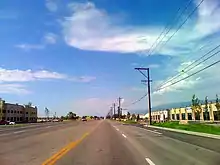
State Route 68 (SR-68) is a state highway in the U.S. state of Utah. It is a major thoroughfare throughout the Wasatch Front as it runs north–south for 70.832 miles (113.993 km), linking U.S. Route 6 (US-6) near Elberta to US-89 in Bountiful. The route intersects several major freeways and highways in the Salt Lake City metropolitan area including Interstate 215 (I-215), I-80, and I-15. The route is more commonly referred to as Redwood Road, after the street it is routed along throughout Salt Lake County. The highway is also routed for a short distance along 500 South and 200 West in Bountiful and Camp Williams Road in Utah County. The route is a surface street for its entire length.
SR-68 became a state highway in 1931, at which time the route ran from then–US-40 (North Temple Street) in Salt Lake City to present-day US-89 in Lehi. In 1933, the route was extended north to US-89 in Becks. SR-68 was routed onto Redwood Road in 1943, taking over what had been designated SR-153. In 1960, SR-68 switched alignments with SR-249 to follow Redwood Road and 2300 North to Bountiful; the route was extended south to Elberta at this time also. SR-249 was extended west along a proposed roadway to 2200 West and 2200 North in 1961 before being removed in 1969. In 2001, SR-68 was extended south on a former piece of SR-106 in Bountiful.
Recently selected: Brockway Mountain Drive • List of Interstate Highways in Texas • Mississippi Highway 172
December

New York State Route 74 (NY 74) and Vermont Route 74 (VT 74) are adjoining state highways in the northeastern United States, connected by one of the last remaining cable ferries in North America. Together they extend for 35 miles (56 km) through Essex County, New York, and Addison County, Vermont. NY 74 begins at exit 28 off Interstate 87 (I-87) in the hamlet of Severance in the Adirondack Mountains region of the northern part of New York State. It extends 20.44 miles (32.89 km) to the western shore of Lake Champlain in Ticonderoga. There, the seasonal Fort Ticonderoga – Larrabees Point Ferry carries cars across the state border into Vermont, where VT 74 starts at the lake's eastern shore and terminates 13.26 miles (21.34 km) later at a junction with VT 30 in the town of Cornwall.
NY 74 is a descendant of the historic Ticonderoga and Schroon Turnpike, which was a privately owned highway chartered in 1832, and segments of NY 74 follow the alignment of the original 19th century turnpike. The connecting ferry route predates both NY 74 and VT 74 and began operation in 1759 on an informal basis. The ferry operation formalized at the close of the 18th century and upgraded to a cable system in 1946.
Due to extensive changes in designations in both states during the 20th century, the entire length of the present highway consists of renamed segments from other highways. The New York portion of the cross-state Route 74 west of Ticonderoga was designated as part of NY 73 in the 1930 renumbering of state highways in New York, while the Vermont section carried several different designations from the 1920s to the late 1930s, when it became solely part of VT F-9. NY 73 was extended east to Lake Champlain in the 1950s—replacing NY 347—and VT F-9 was split into VT 73 and VT 74 shortly afterward. The Schroon–Ticonderoga highway was redesignated as NY 74 ca. 1973 after NY 73 was cut back to its current eastern terminus in Elizabethtown.
Recently selected: Utah State Route 68 • Brockway Mountain Drive • List of Interstate Highways in Texas
2011
January
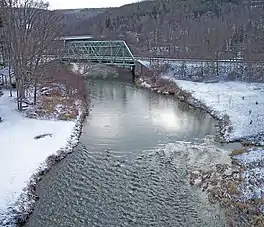
U.S. Route 40 Alternate (Alt US 40) is the United States highway designation for a former segment of U.S. Route 40 (US 40) through Garrett and Allegany Counties in Maryland. The highway begins at US 40 near exit 14 on Interstate 68 and runs 31.80 miles (51.18 km) eastward to Cumberland, where it ends at exit 44 on Interstate 68. Alt US 40 is maintained by the Maryland State Highway Administration (MDSHA).
The highway is known as Old National Pike to reflect the fact that it follows the original alignment of the National Road. As the route of the historic National Road, there are many historic sites along Alt US 40, including the Casselman Bridge in Grantsville and the last remaining National Road toll gate house in Maryland, located in LaVale.
When the National Freeway was built in western Maryland paralleling the old National Road, parts of U.S. Route 40 were bypassed. The part of the bypassed road between Keyser's Ridge and Cumberland became Alt US 40, and other bypassed sections east of Cumberland became Maryland Route 144 and U.S. Route 40 Scenic. Although Alt US 40 has diminished in importance from its original status as the National Road due to the construction of Interstate 68, it remains an important route for local traffic and serves as the Main Streets of Grantsville and Frostburg.
Recently selected: State Route 74 (New York – Vermont) • Utah State Route 68 • Brockway Mountain Drive
February

U.S. Route 199 (US 199) is a U.S. highway in the U.S. states of California and Oregon. The highway was established in 1926 as a spur of U.S. Route 99, which has since been replaced by Interstate 5. US 199 stretches 80 miles (130 km) from U.S. Route 101 near Crescent City, California northeast to Interstate 5 in Grants Pass, Oregon. The highway is the northern portion of the Redwood Highway. In Oregon, US 199 is officially known as Redwood Highway No. 25. The majority of the road in California is the Smith River Scenic Byway, a Forest Service Byway. This route is part of the California Freeway and Expressway System and is eligible for the State Scenic Highway System. The first roadway, a plank road, from Crescent City was established in May 1858, and before the US 199 designation was applied to the highway, the roadway was designated Highway 25 and Route 1.
Recently selected: U.S. Route 40 Alternate (Keysers Ridge – Cumberland, Maryland) • State Route 74 (New York – Vermont) • Utah State Route 68
March
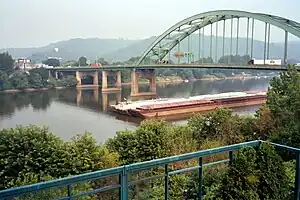
Interstate 70 (I-70) in the U.S. state of West Virginia crosses the Northern Panhandle region, through Ohio County and the city of Wheeling. The shortest segment of I-70 in any state it crosses is the segment in West Virginia, spanning 14.45 miles (23.26 km) across the panhandle. The portion of the route in West Virginia begins on a bridge between the eastern border of Ohio, over the western channel of the Ohio River, crossing onto Wheeling Island. The Fort Henry Bridge carries I-70 across the main channel of the Ohio River and onto mainland West Virginia.
The city of Wheeling sits on the eastern banks of the Ohio River, and I-70 passes over the town on an elevated structure before entering the Wheeling Tunnel. On the other side of the tunnel, the highway meets the eastern terminus of I-470, a bypass of Wheeling. Before the highway crosses into Pennsylvania, I-70 passes The Highlands, a major shopping center in the panhandle. The first portions of the freeway were opened in 1963, and construction was completed in 1971. On average, between 32,000 and 60,000 vehicles use the freeway every day.
Recently selected: U.S. Route 199 • U.S. Route 40 Alternate (Keysers Ridge – Cumberland, Maryland) • State Route 74 (New York – Vermont)
April 1 (April Fool's Day)

The South Pole Traverse, also called the McMurdo – South Pole Highway, is an approximately 900-mile (1450 km) compacted snow road in Antarctica that links the United States' McMurdo Station on the coast to the Amundsen–Scott South Pole Station. Completed during the 2007–2008 austral summer season, it was constructed by leveling snow and filling in crevasses, but is not paved; flags mark its route.
The project was funded by the United States National Science Foundation to provide a lower cost, potentially more reliable method of supplying the South Pole Station. The traverse saves an estimated 40 flights and lowers the carbon footprint over the use of aircraft. A NSF press release from February 7, 2006, stated that 110 tons (99,790 kg) of cargo had been successfully delivered overland to the South Pole Station in a "proof of concept" of the highway.
Recently selected: Interstate 70 in West Virginia • U.S. Route 199 • U.S. Route 40 Alternate (Keysers Ridge – Cumberland, Maryland)
April

Route 55 is a state highway in the southern part of New Jersey, United States that is built to freeway standards. Also known as the Veterans Memorial Highway, it runs 40.54 mi (65.24 km) from an intersection with Route 47 in Port Elizabeth north to an interchange with Route 42 in Gloucester County. The Route 55 freeway serves as a main road through Cumberland and Gloucester counties, serving Millville, Vineland, and Glassboro. It is used as a commuter route north to Philadelphia and, along with Route 47, as a route from the Delaware Valley to the Jersey Shore resorts in Cape May County.
What is now Route 55 was originally proposed in the 1950s as a toll road called the Cape May Expressway that was to run from the Walt Whitman Bridge to Cape May. In 1962, the New Jersey Expressway Authority was created to build the Cape May Expressway and the Atlantic City Expressway. However, by 1965, the road to Cape May was turned over to the New Jersey Department of Transportation (NJDOT) and designated as Route 55, which was to run from Westville to Cape May Court House. The first portion of the route opened around Millville in 1969 while the section bypassing Vineland was completed in the 1970s. Route 55 was completed north to Deptford in 1989. Meanwhile, the portion between Route 47 in Port Elizabeth and the Garden State Parkway in Middle Township was canceled in 1975 due to the impact the highway would have on the surrounding environment. However, traffic jams on Route 47 during the summer months and the lack of an adequate evacuation route for the Cape May Peninsula have led officials to reexamine the possibility of extending Route 55 southward to Cape May County.
Recently selected: Interstate 70 in West Virginia • U.S. Route 199 • U.S. Route 40 Alternate (Keysers Ridge – Cumberland, Maryland)
May
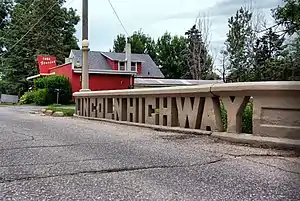
U.S. Route 30 (US 30) is a major east–west U.S. Highway which spans 330 miles (530 km) across the state of Iowa. It is the longest primary highway in the state and is maintained by the Iowa Department of Transportation (Iowa DOT). The route in Iowa begins at the Missouri River crossing at Blair, Nebraska, and ends at the Mississippi River crossing at Clinton. Along the way, it serves Denison and Carroll in western Iowa, Boone, Ames, and Marshalltown in central Iowa, and Tama, Cedar Rapids, and DeWitt in eastern Iowa. Cutting across the central portion of the state, US 30 runs within close proximity of the Union Pacific Railroad's Overland Route for its entire length.
US 30 was originally conceived as a part of the Lincoln Highway, the first transcontinental highway in the United States. A route through Iowa was chosen because of the important link between Omaha, Nebraska, and Chicago, Illinois. As the U.S. Highway System came into being in the 1920s, and the Lincoln Highway became US 30, federal money started to pay for paving Iowa's dirt roads. By 1931, it had been paved across the entire state.
The route of the Lincoln Highway and US 30 has accommodated the changing needs of the traveling public. Early Lincoln Highway travelers were directed into many small towns as the route traveled 358 miles (576 km) across the state. Towards the middle of the 20th century, the route was straightened, bypassing most downtown areas and several towns altogether. More recently, long sections of US 30 have been upgraded to a four-lane expressway to meet the needs of increasing traffic. Since 2006, the highway has been designated the first Iowa Heritage Byway by Iowa DOT.
Recently selected: New Jersey Route 55 • Interstate 70 in West Virginia • U.S. Route 199
June
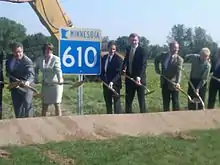
Minnesota State Highway 610 (MN 610) is an east–west freeway in the Twin Cities region of Minnesota; located in northern Hennepin County and southern Anoka County. The freeway currently connects U.S. Highway 169 (US 169) and U.S. Highway 10 (US 10). MN 610 crosses the Mississippi River on the Richard P. Braun Bridge between suburban Brooklyn Park and Coon Rapids.
The freeway was authorized in 1975, and the currently open sections were completed by 2000. There is a segment that is planned to run westward to end at Interstate 94 (I-94), but current construction by the Minnesota Department of Transportation (Mn/DOT) will only extend as far west as County Road 81 (CR 81) in Maple Grove.
Recently selected: U.S. Route 30 in Iowa • New Jersey Route 55 • Interstate 70 in West Virginia
July

Interstate 40 (I-40) is an east–west Interstate Highway that has a 359.6-mile (578.72 km) section in the U.S. state of Arizona connecting sections in California to New Mexico. It enters Arizona from the west at a crossing of the Colorado River southwest of Kingman. It travels eastward across the northern portion of the state connecting the cities of Kingman, Ash Fork, Williams, Flagstaff, Winslow, and Holbrook. I-40 continues into New Mexico, heading to Albuquerque. The highway has major junctions with U.S. Route 93 (US 93) in Kingman, the main highway connecting Phoenix and Las Vegas, Nevada, and I-17 in Flagstaff, the Interstate linking Phoenix and Flagstaff.
For the majority of its routing through Arizona, I-40 follows the historic alignment of U.S. Route 66. The lone exception is a stretch between Kingman and Ash Fork where US 66 took a more northerly, less direct route that is now State Route 66. Construction of I-40 was ongoing in the 1960s and 1970s and reached completion in 1984. With the completion of I-40 in 1984, the entire routing of US 66 had been bypassed by Interstate Highways which led to its decertification a year later in 1985.
Recently selected: Minnesota State Highway 610 • U.S. Route 30 in Iowa • New Jersey Route 55
August

The Capitol Loop is a state trunkline highway running through Lansing, Michigan, in the United States that was commissioned on October 13, 1989. It forms a loop route off Interstate 496 (I-496) through downtown near the Michigan State Capitol complex, home of the state legislature and several state departments. The Michigan Department of Transportation (MDOT) has labeled it as Capitol Loop I-496 or CL I-496 on some maps, similar to the Business Loop Interstate nomenclature. However, unlike other business loops in Michigan, it has unique reassurance markers—the signs that serve as regular reminders of the name and number of the highway. It is known internally at MDOT as Connector 496 for inventory purposes. The route follows a series of one-way and two-way streets through downtown Lansing, directing traffic downtown to the State Capitol and other government buildings. Unlike the other streets downtown, the seven streets comprising the Capitol Loop are under state maintenance and jurisdiction.
The loop was originally proposed in 1986 as part of a downtown revitalization effort. Almost from the beginning before the highway was commissioned in 1989, it was affected by controversial proposals. Several suggestions by community leaders to rename city streets in honor of Martin Luther King Jr. were rejected. In the end, Logan Street was given a second name, Martin Luther King Jr. Boulevard, and the original name was eventually dropped.
Meetings beginning in 1999 dealt with rebuilding the streets as part of a downtown beautification project. The project was delayed to accommodate replacing the sewer system under the roadway at the same time as the streetscaping. The downtown business community protested the original scope of construction, and the Lansing City Council threatened to cancel the project in response to the controversy. Instead of losing the investment in the downtown area, the scope of the project was reduced in scale, and the project was completed in 2005, three months ahead of schedule. In 2010, additional controversies surfaced regarding the posting and enforcement of speed limits on city streets in Michigan, including the streets that make up the Capitol Loop. The newest controversy over speed limits is related to compliance with a 2006 state law aimed at eliminating speed traps.
Recently selected: Interstate 40 in Arizona • Minnesota State Highway 610 • U.S. Route 30 in Iowa
September

Interstate 80 Business (BL-80) is a business loop of Interstate 80 (I-80) that is 2.26 miles (3.64 km) long and serves as the main street for the towns of West Wendover, Nevada and Wendover, Utah along a roadway named Wendover Boulevard. Wendover Boulevard was originally part of U.S. Route 40 (US 40), which connected California to New Jersey via Nevada and Utah. A portion of the Nevada segment is concurrent with U.S. Route 93 Alternate (US 93 Alt.), and the entire portion in Utah is coterminous with Utah State Route 58 (SR-58). The Nevada Department of Transportation (Nevada DOT) applied for the business loop designation in the early 1980s but the designation has never been approved, despite signs being posted in both states. Between July 1976 and 1993, BL-80 was concurrent with State Route 224 (SR 224) in Nevada.
Recently selected: Capitol Loop • Interstate 40 in Arizona • Minnesota State Highway 610
October
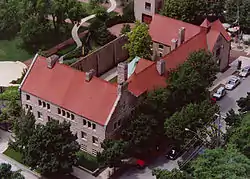
Prairie Avenue is a north–south thoroughfare on the South Side of Chicago, which historically extended from 16th Street in the Near South Side community area of Chicago in Cook County, Illinois, United States, to the city's southern limits and beyond. The street has a rich history from its origins as a major trail for horseback riders and carriages. During the last three decades of the 19th century, a six-block section of the street served as the residence of many of Chicago's elite families and an additional four-block section was also known for grand homes. The upper six-block section includes part of the historic Prairie Avenue District, which was declared a Chicago Landmark and added to the National Register of Historic Places.
Several of Chicago's most important historical figures have lived on the street. This is especially true of the period of recovery from the Great Chicago Fire of 1871 when many of the most important families in the city moved to the street. Residents of the street have influenced the evolution of the city and have played prominent national and international roles. They have influenced the political history, the architecture, the culture, the economy, as well as the law and government of Chicago. The street has over time been influenced by the demographics of Chicago.
The importance of the street has declined, but it still has landmark buildings and is the backbone of an historic district. Preservation battles regarding various properties on the street have been notable with one having been chronicled on the front page of The New York Times. As of 2009, the street is being redeveloped to host valuable and important condominiums. Recently, developments have extended the street north to accommodate new high-rise condominiums, such as One Museum Park, along Roosevelt Road (12th Street). The redevelopment has extended the street so that it has prominent buildings bordering Grant Park with Prairie Avenue addresses.
Recently selected: Interstate 80 Business (West Wendover, Nevada – Wendover, Utah) • Capitol Loop • Interstate 40 in Arizona
November
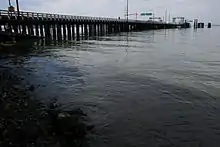
State Route 339 (SR 339) is a 8.5-nautical-mile-long (9.8 mi; 15.7 km) ferry route designated as a state highway in the U.S. state of Washington. It connects Vashon Island's Vashon Heights ferry terminal to downtown Seattle's Pier 50, via a passenger-only ferry, the MV Skagit. The ferry is financed by the King County Ferry District (KCFD) and tolls collected at Pier 50. Despite being part of the KCFD, the ferry is operated by Washington State Ferries (WSF). SR 339 is one of only four ferry routes providing access to and from Vashon Island, and has the lowest annual average ridership of the four routes. The state of Washington took over the operation of the ferry route in 1951, and designated it SR 339 in 1994.
Recently selected: Prairie Avenue • Interstate 80 Business (West Wendover, Nevada – Wendover, Utah) • Capitol Loop
December

The Baltimore–Washington Parkway (also referred to as the B–W Parkway) is a highway in Maryland, running southwest from Baltimore to Washington, D.C. The road begins at an interchange with U.S. Route 50 (US 50) and Maryland Route 201 (MD 201) near Cheverly in Prince George's County at the D.C. border, and continues northeast as a parkway maintained by the National Park Service (NPS) to MD 175 near Fort Meade, serving many federal institutions. This portion of the parkway is dedicated to Gladys Noon Spellman, a representative of Maryland's 5th congressional district, and has the hidden MD 295 designation. Commercial vehicles, including trucks, are prohibited within this stretch. After leaving park service boundaries the highway is maintained by the state and signed with the MD 295 designation. Upon entering Baltimore, the Baltimore Department of Transportation takes over maintenance of the road and it continues north to an interchange with I-95. Here, the Baltimore–Washington Parkway ends and MD 295 continues north unsigned on Russell Street before following Paca Street northbound and Greene Street southbound to US 40 in downtown Baltimore.
Plans for a parkway linking Baltimore and Washington date back to Pierre Charles L'Enfant's original layout for Washington D.C. in the 18th century but did not fully develop until the 1920s. In the mid-1940s, plans for the design of the parkway were finalized and construction began in 1947 for the state-maintained portion and in 1950 for the NPS-maintained segment. The entire parkway opened to traffic in stages between 1950 and 1954. In the 1960s and the 1970s, there were plans to give the segment of the parkway owned by the NPS to the state and make it a part of Interstate 295 (I-295) and possibly I-95; however, they never came through and the entire road is today designated as MD 295, despite only being signed on the state portion. Between the 1980s and the 2000s, the NPS portion of the road was modernized and a part of signed MD 295 is in the process of being widened from four to six lanes, with more widening and a new interchange along this segment planned for the future.
Recently selected: Washington State Route 339 • Prairie Avenue • Interstate 80 Business (West Wendover, Nevada – Wendover, Utah)
2012
January

State Road 404 (SR 404), the Pineda Causeway, is an east–west divided highway currently running from Interstate 95 (I-95) to SR A1A at Patrick Air Force Base, Florida. It was opened as a toll road in 1971 and classified as a state road two years later. The tolls were removed in 1990. It was named after Pineda, a former village east of Suntree on U.S. Route 1 (US 1). With interchanges at US 1 (SR 5), South Tropical Trail (Brevard County Road 3, CR 3), and South Patrick Drive (SR 513), the Pineda Causeway is (along with SR A1A) the primary access for Patrick Air Force Base and the southern end of Merritt Island. From US 1 to the eastern terminus, it is part of the Indian River Lagoon Scenic Highway system.
Recently selected: Baltimore–Washington Parkway • Washington State Route 339 • Prairie Avenue
February

The High Five Interchange is the first five-level stack interchange built in Dallas, Texas. Located at the junction of the Lyndon B. Johnson Freeway (Interstate 635, I-635) and the Central Expressway (US Highway 75, US 75), it replaces an antiquated partial cloverleaf interchange constructed in the 1960s. The $261 million project was initiated in 2002 and completed in December 2005. It was designed by the HNTB Corporation and built by Zachry Construction Corporation. The interchange is considered by Popular Mechanics to be one of "The World's 18 Strangest Roadways" because of its height, its 37 permanent bridges and other unusual design and construction features. In 2006, the American Public Works Association named the High Five Interchange as "Public Works Projects of the Year."
Recently selected: Florida State Road 404 • Baltimore–Washington Parkway • Washington State Route 339
March
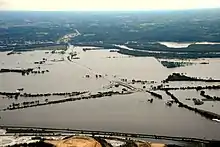
Interstate 680 (I-680) in Nebraska and Iowa is the northern bypass of the Omaha, Nebraska – Council Bluffs, Iowa, metropolitan area. I-680 spans 42.86 miles (68.98 km) from its western end in western Omaha to its eastern end near Neola, Iowa. For a 10-mile (16 km) stretch, I-680 is co-signed with I-29. The freeway passes through a diverse range of scenes and terrains – the urban setting of Omaha, the Missouri River and its valley, the rugged Loess Hills, and the farmland of Pottawattamie County, Iowa.
Until 1973, the section in Iowa between the current eastern end and I-29 was designated as I-80N. I-680 in Omaha was originally designated I-280. Maps from the early and mid-1960s showed I-280 in Omaha. Since this highway would extend into Iowa, and I-280 was already planned for the Quad Cities area, this route was redesignated I-680.
Recently selected: High Five Interchange • Florida State Road 404 • Baltimore–Washington Parkway
April 1 (April Fool's Day)

M-185 is a state trunkline highway in Michigan that circles the shoreline of Mackinac Island, a popular tourist destination on the Lake Huron side of the Straits of Mackinac. A narrow paved road of 8.004 miles (12.881 km), it is "the only state highway in the nation where motor vehicles are banned" according to the Michigan Department of Transportation. These restrictions on automobiles date back to the 1890s, and since the ban, only a few vehicles have been permitted on the island other than the city's emergency vehicles. In 2005, it was site of the island's only automobile accident. The highway offers scenic views of the straits that divide the Upper and the Lower peninsulas of Michigan and Lakes Huron and Michigan. It is disconnected from other state trunkline highways—as it is on an island—and is accessible only by passenger ferry. M-185 passes by several key sites within Mackinac Island State Park and has been recommended as a tourist destination for disabled veterans as well as photographers. The highway was built during the first decade of the 20th century by the state and designated as a state highway in 1933. The road was paved in the 1950s, and portions were rebuilt to deal with shoreline erosion in the 1980s.
Recently selected: Interstate 680 • High Five Interchange • Florida State Road 404
April
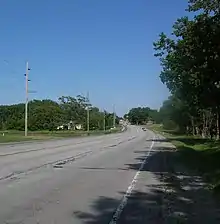
U.S. Route 20 (US 20) in Indiana is a main east–west highway that is parallel to the Indiana Toll Road. The western terminus of US 20 is at the Illinois state line and the eastern terminus is at the Ohio state line. US 20 through Whiting, East Chicago, and Gary is concurrent with US 12 twice. The route varies between one-way, two-lane, and four-lane streets, in northwestern Indiana. East of Gary to Michigan City, the road is a two-lane highway. From Michigan City to west of South Bend, US 20 is a four-lane undivided highway. The route then heads around the west and south sides of South Bend and Elkhart. East of Elkhart County Road 17 (CR 17), US 20 is two-lane rural highway.
US 20 was part of the Dunes Highway from the Illinois state line to Michigan City, concurrent with US 12. The Dunes Highway started being paved in 1922. The section of the highway, that is known as Lincoln Way as part of the 1913 section of the Lincoln Highway. Indiana State Highway Commission, later renamed Indiana Department of Transportation, began signing US 20 in 1926. US 20 went through downtown South Bend and Elkhart before the St. Joseph Valley Parkway was built. Before the parkway was completed, the route that was open to traffic was called Bypass US 20. A small realignment in LaGrange County was done in 2005, in which the roadway was straightened. Other small realignments included the route through Michigan City, which followed US 35 from US 12 to I-94.
Recently selected: Interstate 680 • High Five Interchange • Florida State Road 404
May
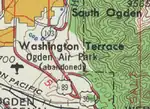
State Route 103 (SR-103) is a 0.225-mile-long (0.362 km) urban minor arterial state highway in the U.S. state of Utah. It branches off from SR-126 in downtown Clearfield and extends east to Interstate 15 (I-15), terminating at Hill Air Force Base. The entire route is located in Davis County and was formed in 1965 coinciding with the construction of I-15. The eastern terminus has changed hands in the same location several times since its designation, and the route was eventually given the moniker of 650 North in 1979. SR-103 is one of four Utah state highways that connect to Hill Air Force Base, the others being SR-97, SR-168 and SR-232, and has the second lowest average daily traffic, higher only than SR-168.
Recently selected: U.S. Route 20 in Indiana • Interstate 680 • High Five Interchange
June

Guam Highway 1 (GH-1), also known as Marine Corps Drive, is one of the primary automobile routes in the United States territory of Guam. It runs in a southwest-to-northeast direction, from the main gate of Naval Base Guam in the western community of Santa Rita in a general northeasterly direction to the main gate of Andersen Air Force Base in the community of Yigo. It passes through Guam's capital, Hagåtña, as well as intersecting various other territorial highways. Along its route, the highway runs through tropical forest areas, urbanized commercial areas, and residential neighborhoods. The US Military built the road starting in 1941. Construction ceased with the Japanese invasion in December 1941 and resumed in 1944. The highway was formally dedicated to the US Marines by the territorial governor in 2004.
Recently selected: Utah State Route 103 • U.S. Route 20 in Indiana • Interstate 680
July
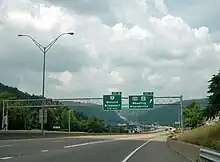
Interstate 470 (I-470) is a 10.63-mile (17.11 km) long loop of Interstate 70 bypassing the city of Wheeling, West Virginia. The western terminus of the freeway is at an interchange with I-70 near Blaine, Ohio. Traveling southeast through rural Belmont County, the highway approaches the Vietnam Veterans Memorial Bridge carrying I-470 over the Ohio River. After crossing the river into Ohio County, West Virginia, the highway turns northeast, towards the Wheeling neighborhood of Elm Grove and its eastern terminus at I-70 near Wheeling Park. Construction began in 1975 in the two states but due to a chronic lack of funding, construction in Ohio was stalled between 1976 and 1981. By 1983, both states had completed construction on the freeway. The three-level diamond interchange with concurrent highways U.S. Route 250 (US 250) and West Virginia Route 2 (WV 2) on the eastern banks of the Ohio River was thought to be the most complex interchange in West Virginia's Interstate Highway System at the time of construction. On average, between 26,000 and 38,000 vehicles use the highway daily. During the reconstruction work on the Wheeling Tunnel, I-470 was one of two suggested detour routes to avoid the closed tunnel.
Recently selected: Guam Highway 1 • Utah State Route 103 • U.S. Route 20 in Indiana
August
Georgia State Route 40 (SR 40) is a state highway in the U.S. state of Georgia. The highway runs 30.46 miles (49.02 km) from U.S. Route 1, US 23, US 301, SR 4, and SR 15 in Folkston east to Church Street in St. Marys. SR 40 is the primary east–west highway of eastern Charlton County and southern Camden County. The highway connects Folkston and St. Marys with Kingsland, where the route meets Interstate 95 (I-95) and US 17. SR 40 also serves as much of the route from I-95 to Naval Submarine Base Kings Bay and Cumberland Island National Seashore. SR 40 was assigned to the Folkston–St. Marys highway in the early 1920s. The highway was first improved in the mid-1920s and paved in the mid-1930s from Kingsland to St. Marys. SR 40 was paved from Folkston east to the Charlton–Camden county line in the late 1930s and from the county line to Kingsland in the early 1940s. The highway was extensively relocated between Folkston and Kingsland in the mid-1960s. SR 40 was expanded to four lanes, much of it divided highway, east of Kingsland in the 1980s. The Georgia Department of Transportation (GDOT) has long-term plans to expand the state highway to a four-lane divided highway from Folkston to Kingsland. The first portion of this project was completed east of Folkston in the mid-2000s.
Recently selected: Interstate 470 (Ohio–West Virginia) • Guam Highway 1 • Utah State Route 103
September

Interstate 470 (I-470) is a 16.72-mile (26.91 km) loop of the Interstate Highway System that serves to link southeast Kansas City to Independence via Lee's Summit in Jackson County, Missouri. The western terminus of the freeway is at the Grandview Triangle interchange while the northern terminus is an cloverleaf interchange with I-70. The freeway travels west to east through southern Kansas City, curving towards the north at the Lee's Summit Municipal Airport and becoming concurrent with Missouri Route 291 (Route 291) as the highway travels north towards Independence. An intermediate interchange with U.S. Route 50 (US 50) provides access to southern Jackson County, and to Raytown to the north via Route 350, a former alignment of US 50 before the construction of I-470. Plans for a southern freeway were first published in 1955, and the first portions of I-470 were completed in 1970. By 1983 the entire freeway was open to traffic. Since construction two new interchanges have been constructed, along with the expansion of the US 50 cloverleaf. In 2010, part of the freeway was closed by the Grandview Triangle due to a landslide underneath the freeway. Between about 38,000 and 75,000 vehicles use the freeway on an average day.
Recently selected: Georgia State Route 40 • Interstate 470 (Ohio–West Virginia) • Guam Highway 1
October

State Route 57 (SR 57), also known as the Orange Freeway, is a north–south state highway in the Greater Los Angeles Area of California. It connects the interchange of Interstate 5 (I-5) and SR 22 near downtown Orange, locally known as the Orange Crush, to the Glendora Curve interchange with I-210 and SR 210 in Glendora. The highway provides a route across several spurs of the Peninsular Ranges, linking the Los Angeles Basin with the Pomona Valley and San Gabriel Valley. A predecessor to this road ran through Brea Canyon by the early 20th century and was added to the state highway system. The freeway was built in stages during the 1950s, one of which included the Brea Canyon Freeway; SR 57 was designated as part of the 1964 state highway renumbering. The final portion of the present-day Orange Freeway was not completed until the early 1970s. The latest piece of SR 57 to be added was formerly part of I-210, after SR 210 was extended to San Bernardino in 1998. An unconstructed extension from Santa Ana south to Huntington Beach remains in the legal definition of Route 57, and has been studied most recently as a toll road above the Santa Ana River.
Recently selected: Interstate 470 (Missouri) • Georgia State Route 40 • Interstate 470 (Ohio–West Virginia)
November

New York State Route 311 (NY 311) is a state highway located entirely within Putnam County, New York, in the United States. The highway begins at NY 52 in Lake Carmel, and intersects Interstate 84 (I-84) shortly thereafter. It crosses NY 164 and NY 292 as it heads into the northeastern part of the county, finally curving east to reach its northern terminus at NY 22 just south of the Dutchess County line. The route passes several historical sites. Part of modern-day Route 311 was originally the Philipstown Turnpike, a road built in 1815 to overcome a lack of transportation when the Hudson River froze during the winter months. The turnpike was a large business center for the county, though it was abandoned due to insufficient tolls to maintain it. Another section was constructed in the early 1900s, from the Patterson Baptist Church near the modern-day intersection of Route 311 and Route 164 to the Village of Patterson, by a group of Italian immigrants. In the 1930 renumbering of state highways in New York, the segment of former NY 39 east of West Patterson was renumbered to NY 311. NY 52 was realigned c. 1937 to follow its current alignment between Stormville and Lake Carmel. The former routing of NY 52 from West Patterson to Lake Carmel became part of an extended NY 311.
Recently selected: California State Route 57 • Interstate 470 (Missouri) • Georgia State Route 40
December
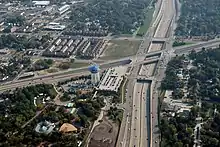
Interstate 696 (I-696) is an east–west auxiliary Interstate Highway in the US state of Michigan. The state trunkline highway is also known as the Walter P. Reuther Freeway, named for the prominent auto industry union head by the Michigan Legislature in 1971. I-696 is a bypass route, detouring around the city of Detroit through the city's northern suburbs in Oakland and Macomb counties. It starts by branching off I-96 and I-275 at its western terminus in Novi, and runs through suburbs including Southfield, Royal Oak and Warren before merging into I-94 at St. Clair Shores on the east end. It has eight lanes for most of its length and is approximately 10 miles (16 km) north of downtown Detroit. I-696 connects to other freeways such as I-75 and M-10. Local residents sometimes refer to the freeway as "The Autobahn of Detroit." Planning for the freeway started in the 1950s, and construction started on the first segment in 1961. The western third of the freeway opened in 1963, and the eastern third was completed in January 1979. The central segment was the subject of much controversy during the 1960s and 1970s. Various municipalities along this stretch argued over the routing of the freeway and various groups used federal environmental regulations to force changes to the freeway. The Orthodox Jewish community in Oak Park was concerned about pedestrian access across the freeway; I-696 was built with a set of parks on overpasses to accommodate their needs. The Detroit Zoo and the City of Detroit also fought components of the freeway design. These concessions delayed the completion of I-696 until December 15, 1989.
Recently selected: New York State Route 311 • California State Route 57 • Interstate 470 (Missouri)
2013
January
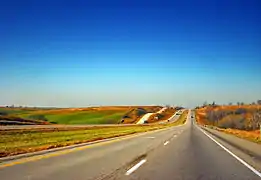
Interstate 80 (I-80) is a transcontinental Interstate Highway in the United States, stretching from San Francisco, California, to Teaneck, New Jersey. In Iowa, the highway travels west to east through the center of the state. It enters the state at the Missouri River in Council Bluffs and heads east through the southern Iowa drift plain. In the Des Moines area, I-80 meets up with I-35 and the two routes bypass Des Moines together. In Ankeny, the interstates split and I-80 continues east. In eastern Iowa, it provides access to the University of Iowa in Iowa City. I-80 passes along the northern edge of Davenport and Bettendorf and leaves Iowa via the Fred Schwengel Memorial Bridge over the Mississippi River into Illinois. The I-80 corridor was originally served by two competing auto trails, the Great White Way and the River-to-River Road, which later became U.S. Route 32 (US 32) in 1926 and then US 6. In the early 1950s, plans were drawn up to build a limited-access road called the Iowa Turnpike until the Interstate Highway System was created in 1956. Construction of I-80 took place over 14 years, with the road being opened in parts between 1958 and 1972. By the 1980s, I-80 had fallen into disrepair in Iowa and across the country. Federal funding was freed up in 1985 to allow reconstruction of the highway.
Recently selected: Interstate 696 • New York State Route 311 • California State Route 57
February

U.S. Route 60 (US-60) is a transcontinental U.S. highway extending from near Brenda, Arizona to Virginia Beach, Virginia on the Atlantic Ocean. Along the way, 352.39 miles (567.12 km) of the route lies within the state of Oklahoma. The highway crosses into the state from Texas west of Arnett and serves many towns and cities in the northern part of the state, including Arnett, Seiling, Fairview, Enid, Ponca City, Pawhuska, Bartlesville, and Vinita. US-60 exits Oklahoma near Seneca, Missouri. The first 60.2 miles (96.9 km) of the route, from the Texas line to Seiling, is also designated as State Highway 51 (SH-51). US-60, as originally designated, did not enter Oklahoma. Instead, it ended in Springfield, Missouri, continuing east from there. AASHO approved an extension of US-60 on May 29, 1930, which extended it west through Oklahoma to Amarillo, Texas. US-60's extension displaced US-164 in its entirety; that designation was then retired.
Recently selected: Interstate 80 in Iowa • Interstate 696 • New York State Route 311
March

Interstate 270 (I-270) is a 7-mile (11 km) long highway in the northeastern part of the Denver–Aurora Metropolitan Area in the U.S. state of Colorado. It overlaps U.S. Highway 36 (US 36) for its entire length. The western terminus of I-270 is at the interchange with I-25 and US 36. It heads eastward to an interchange with I-76, where the mileposts reset because of a previous freeway extension. The freeway heads southeast and comes to meet Vasquez Boulevard, where it enters Commerce City. The road crosses Quebec Street before ending at I-70. Ground was broken on the first segment of I-270 in 1965, and the freeway was completed three years later, stretching from I-70 to Vasquez Boulevard. The road was then extended to I-76 two years later. The section between I-25 and I-76 was completed in 1999. Since completion, this section has undergone much construction to renew bridges over Clear Creek and Washington Street. Because the western end of I-270 is close to the junction of I-25 and I-76, some traffic movements to I-25 can only be made by using I-76.
Recently selected: U.S. Route 60 in Oklahoma • Interstate 80 in Iowa • Interstate 696
April 1 (April Fool's Day)

Ohio State Route 732 (OH 732) is a very important state highway near the Indiana border in the state of Ohio. The route crosses through Butler and Preble counties as a two-lane roadway. 30.96 miles (49.83 km) in length, the route begins at an intersection in front of multiple trees with OH 129 in Reily Township and ends in front of more trees at an intersection with US 35, US 127 and OH 122 in Eaton. During this stretch, it crosses through many important places, including the city of Oxford and a township named after a Middle Eastern country.
The route also serves the Hueston Woods State Park in Preble County, where it passes its most important landmark, a very large autumn beach tree near the park entrance. This tree is important to the road's creation, which dates back to March 1811 and even during the times when a very mad man crossed through the area. When driving on OH 732, travelers tend to stop in front of the park to see this magnificent landmark on the side of the road, despite the other points along the roadway. It is on the nominations list to soon make the National Register of Historic Places as the first tree significant to history and is expected to pass.
Recently selected: Interstate 270 (Colorado) • U.S. Route 60 in Oklahoma • Interstate 80 in Iowa
April

U.S. Route 197 (US 197) is a north–south United States Highway, of which all but 2.76 miles of its 69.93 miles (4.44 of 112.54 km) are within the state of Oregon. The highway starts in rural Wasco County in Central Oregon at an intersection with US 97. US 197 travels north as a continuation of The Dalles-California Highway No. 4 through the cities of Maupin, Tygh Valley, and Dufur to The Dalles. Within The Dalles, the highway becomes concurrent with US 30 and intersects Interstate 84 (I-84) before it crosses over the Columbia River on the The Dalles Bridge into Washington. The highway continues through the neighboring city of Dallesport in Klickitat County and terminates at a junction with State Route 14 (SR 14).
US 197 was established in 1952 using the existing The Dalles-California Highway, itself created as a part of the initial named Oregon highways in 1917. US 197 traveled from its current northern terminus at Dallesport to US 97 in Maryhill along Primary State Highway 8 (PSH 8) and US 830, successors to the original State Road 8 designated along the corridor in 1907. The Dallesport–Maryhill section was transferred to SR 14 in 1979, but was not recognized by the American Association of State Highway and Transportation Officials (AASHTO) until 2006.
Recently selected: Interstate 270 (Colorado) • U.S. Route 60 in Oklahoma • Interstate 80 in Iowa
May

The State Trunkline Highway System consists of all the state highways in Michigan, including those designated as Interstate, United States, or State Trunkline highways. Maintained by the Michigan Department of Transportation, the system comprises 9,716 miles (15,636 km) of trunklines in all 83 counties of the state. Its components range in scale from 10-lane urban freeways to two-lane rural undivided highways to a non-motorized highway on Mackinac Island, where cars are forbidden. The longest highway is nearly 400 miles (640 km) long, while the shortest is about three-quarters of a mile (about 1.2 km). On May 13, 1913, the State Reward Trunk Line Highways Act was passed, creating the system. Highway numbers were first posted on signs in 1919, making Michigan the second state to do so. Michigan's first freeways were built during the 1940s. Construction on Michigan's Interstates started in the late 1950s and continued until 1992. Few additional freeways have been built since 1992, and in the early years of the 21st century, projects are underway to bypass cities with new highways.
Recently selected: U.S. Route 197 • Interstate 270 (Colorado) • U.S. Route 60 in Oklahoma
June

Route 37, also known as the Lincoln Avenue Freeway, is a numbered state highway running 3.47 miles (5.58 km) in Providence County and Kent County, Rhode Island, United States. The route is a nominally east–west freeway for its entire length. Route 37 serves the cities of Cranston and Warwick and is also a major east–west freeway in the Providence metropolitan area. The western terminus of Route 37 is an at-grade intersection with Natick Avenue in Cranston. The eastern terminus is a trumpet interchange with U.S. Route 1 in Warwick. Originally conceived as a freeway linking Scituate with suburban Warwick, the proposed alignment of Route 37 was later shortened to an alignment linking I-295 with I-95. Construction on the freeway began in 1963 and was completed by 1969. An eastward extension was proposed in 1966; it was to be designated I-895, but the extension was ultimately canceled. In the 1980s, Route 37 was included in proposals for an eastward extension of Interstate 84 from Hartford, Connecticut to Rhode Island, but this alignment was also canceled. RIDOT has long-range plans to extend Route 37 east to Route 117 in Downtown Warwick, but plans for a westward extension have been abandoned.
Recently selected: Michigan State Trunkline Highway System • U.S. Route 197 • Interstate 270 (Colorado)
July
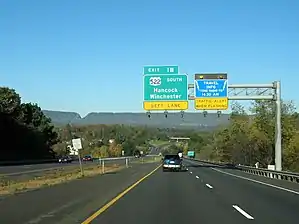
Interstate 70 (I-70) is a part of the Interstate Highway System that runs from Cove Fort, Utah to Baltimore, Maryland. In Maryland, the Interstate Highway runs 93.62 miles (150.67 km) from the Pennsylvania state line in Hancock east to a park and ride lot east of I-695. I-70 is the primary east–west Interstate in Maryland. I-70's route from Frederick to West Friendship was constructed as a divided highway relocation of US 40 in the early to mid-1950s and a freeway bypass of Frederick in the late 1950s. The first section of the Interstate to be marked as I-70 was an upgrade of US 40 near Hancock in the early 1960s. The remainder of the Interstate highway in Maryland west of Frederick was built on a new alignment in the mid- to late 1960s. I-70 was constructed from West Friendship to its present terminus in Baltimore in the late 1960s. The highway from Bartonsville in Frederick County to West Friendship was upgraded to Interstate standards in the mid-1970s. The final non-limited access portion of I-70 between Frederick and Bartonsville was eliminated in the mid-1980s. The Interstate is presently being upgraded through Frederick in a series of projects that began in the late 1990s. I-70 was originally planned to continue into Baltimore and end at I-95 and I-83, but that part was cancelled due to opposition.
Recently selected: Rhode Island Route 37 • Michigan State Trunkline Highway System • U.S. Route 197
August
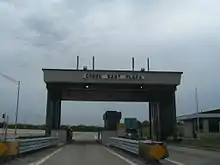
The Creek Turnpike is a 33.22-mile-long (53.46 km) freeway-standard toll road that lies entirely in the U.S. state of Oklahoma. The turnpike forms a partial beltway around the south and east sides of Tulsa, Oklahoma's second largest city. The Creek Turnpike's western terminus is at the Turner Turnpike in Sapulpa, while its northeastern terminus is at the Will Rogers Turnpike in Fair Oaks; both ends of the Creek Turnpike connect with Interstate 44 (I-44). Along the way, the highway passes through the cities of Sapulpa, Jenks, Tulsa, and Broken Arrow. The first section of the Creek Turnpike, from US-75 in Jenks to US-64/US-169 in Tulsa, was first authorized in 1987, with construction beginning in 1989. The turnpike's construction was controversial from opposition from homeowners and environmental concerns. The highway opened to traffic in three sections over the course of the first half of 1992. Further extensions to both the east and the west followed in later years after several years of false starts under the administrations of two different governors. Expansion of the highway was finally approved in 1998, with the entire road completed by 2002.
Recently selected: Interstate 70 in Maryland • Rhode Island Route 37 • Michigan State Trunkline Highway System
September

California State Route 52 (SR 52) is a state highway in San Diego County, California, that extends from La Jolla Parkway at Interstate 5 (I-5) in La Jolla, San Diego, to SR 67 in Santee. A freeway for its entire length, it serves as a major east–west route through the northern part of the city of San Diego and connects the major north–south freeways of the county. SR 52 passes north of the Rose Canyon Fault before traversing Marine Corps Air Station Miramar (MCAS Miramar). East of Santo Road and west of SR 125, the highway goes through Mission Trails Regional Park, a large open preserve. Plans for a route between La Jolla and Santee date from 1959, and SR 52 was officially designated in the 1964 state highway renumbering. Construction of the freeway east of Santo Road encountered delays from environmentalists over the endangered Least Bell's Vireo, a songbird that faced habitat destruction, as well as those concerned with the destruction of homes and businesses. The extension to Mission Gorge Road opened in 1993, but funding issues delayed the completion of the entire route to Santee until 2011, more than fifty years after construction began.
Recently selected: Creek Turnpike • Interstate 70 in Maryland • Rhode Island Route 37
October

New York State Route 174 (NY 174) is a state highway in Onondaga County, located in Central New York, in the United States. The highway is 16.7 miles (26.9 km) long and passes through mostly rural regions. Route 174 begins at an intersection with NY 41 in Borodino, a hamlet of Spafford. It heads generally northward for most of its length, except for short distances in the villages of Marcellus and Camillus. The route ends at a junction with NY 5 west of Camillus, at the west end of the Route 5 Camillus bypass. Route 174 is located along a large mapped sedimentary bedrock unit, known as the Marcellus Formation. The formation is named for an outcrop found near the town of Marcellus, New York, during a geological survey in 1839. The road was first constructed in the early 19th century following the path of Nine Mile Creek. The northern half of the route became a plank road in 1855 by a private corporation that collected tolls from travelers on the road. The state took over the maintenance of the road by the beginning of the 20th century. The former plank road and an extension south to Otisco Lake and southwest to Skaneateles Lake was first designated as Route 174 in the 1930 state highway renumbering. Since then, several minor realignments have been made in the areas of the villages of Marcellus and Camillus to accommodate newly built bypasses.
Recently selected: California State Route 52 • Creek Turnpike • Interstate 70 in Maryland
November
_(4).jpg.webp)
Interstate 70 (I-70) is a mainline route of the Interstate Highway System in the United States connecting Utah and Maryland. The Utah section runs east–west for 232.15 miles (373.61 km) across the central part of the state. I-70 was the second attempt to connect southern California to the east coast of the United States via central Utah, the first being a failed attempt to construct a transcontinental railroad.
Portions of I-70 were constructed in areas where previously there were no paved roads. I-70 has many features that are unique in the Interstate Highway System. For example, the 110 miles (177 km) between Green River and Salina makes up the longest distance anywhere in the Interstate Highway System with no motorist services. This same piece is noted as the longest highway in the United States built over a completely new route since the Alaska Highway, and the longest piece of Interstate Highway to open at a given time. The construction of the Utah portion of I-70 is listed as one of the engineering marvels of the Interstate Highway System.
The choice of the route had a significant impact on the character and culture of the Sevier Valley. I-70 from Green River to Grand Junction, Colorado is part of the Dinosaur Diamond Prehistoric Highway, a National Scenic Byway. Attractions on or near I-70 include, Arches National Park, Canyonlands National Park, Cleveland-Lloyd Dinosaur Quarry, Goblin Valley State Park and Westwater. The designation lists several side roads branching from I-70 that lead to dinosaur bones or footprints.
Recently selected: New York State Route 174 • California State Route 52 • Creek Turnpike
December

U.S. Highway 8 (US 8) is a United States Numbered Highway that runs primarily east–west for 280 miles (451 km), mostly within the state of Wisconsin. It runs from Interstate 35 (I-35) in Forest Lake, Minnesota, to US 2 at Norway in the Upper Peninsula of Michigan near the border with Wisconsin. Except for the short freeway segment near Forest Lake, and sections near the St. Croix River bridge and Rhinelander, Wisconsin, it is mostly undivided surface road. The highway was originally commissioned on November 11, 1926, with the rest of the original U.S. Highway System. At the time, it ran between Forest Lake, Minnesota, and Pembine, Wisconsin, with a planned continuation on to Powers, Michigan. Several changes have been made to the routing of the highway since then. The western end was extended south to Minneapolis before it was truncated back to Forest Lake. Other changes on the east end have moved that terminus from the originally planned end location at Powers, to the current location in Norway. US 8's course through the three states has also been shifted to follow different alignments over the years. WisDOT built a bypass around the city of Rhinelander in the 1990s and created a business loop along the old highway through the town. This loop was a locally maintained route through the central business district in Rhinelander. The signage for the loop was removed in 2005.
Recently selected: Interstate 70 in Utah • New York State Route 174 • California State Route 52
2014
January

State Route 89A (SR 89A) is a 83.85-mile (134.94 km) state highway that runs from Prescott north to Flagstaff in the U.S. state of Arizona. The highway begins at SR 89 and heads northward from Prescott, entering Jerome. From Jerome, the route then heads to Cottonwood and Sedona. The highway is notable for its scenic value as it passes through Sedona and the Oak Creek Canyon. The route then enters Flagstaff, where it crosses Interstate 17 (I-17) and I-40. The highway ends at I-40 Business in Flagstaff. What is now SR 89A became a state highway in the late 1920s as SR 79. The highway was extended and improved several times through 1938. SR 79 was renumbered to U.S. Route 89A (US 89A) in 1941 and then to SR 89A in the early 1990s.
Recently selected: U.S. Route 8 • Interstate 70 in Utah • New York State Route 174
February

The Wendover Cut-off, also called the Wendover Road or Wendover Route, is a two-lane highway in the western part of Tooele County in the U.S. state of Utah. Stretching 40.3 miles (64.9 km) from Wendover to Knolls across the Bonneville Salt Flats, a part of the Great Salt Lake Desert, the cut-off was once part of the primary link between the Nevada state line and Salt Lake City. The first roadway across the Great Salt Lake Desert was completed in 1917 as a single-lane highway. It was added to the Utah state highway system in 1919, and replacement plans had begun to arise as soon as 1921. In 1923, the current cut-off was approved for construction and opened in 1925. The United States Numbered Highway System brought the arrival of the U.S. Route 40 (US-40) designation to the highway, the Lincoln Highway was also routed along the cut-off. Later, the cut-off was also designated as part of US-50 and US-50 Alternate (US-50 Alt). Upon the completion of the parallel Interstate 80 (I-80), the previous U.S. Route designations were deleted from the United States Numbered Highway System, and the cut-off was turned over to the county.
Recently selected: Arizona State Route 89A • U.S. Route 8 • Interstate 70 in Utah
March
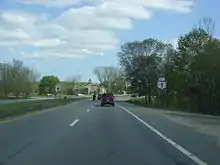
Route 4 is a 10.37-mile (16.69 km) long numbered state highway located in Washington County and southern Kent County, Rhode Island, United States. The route is a major north–south freeway in the southern Providence metropolitan area, directly linking Providence with eastern Washington County, the beaches of Narragansett and South Kingstown, and the city of Newport. Route 4 begins as a two-lane divided highway at an intersection with U.S. Route 1 (US 1) in the town of North Kingstown, becoming a freeway after 1.89 miles (3.04 km). The route continues to the city of Warwick, where the northbound lanes merge into Interstate 95 (I-95). The origins of Route 4 date back to 1952, when construction began on a short, unnumbered arterial from US 1 to Routes 2 and 102 (exit 5) in Wickford. In 1965, work began on a 5.4-mile (8.7 km) freeway from modern exit 6 north to the merge with I-95. The freeway, designated as Route 4, was completed in 1972. The Route 4 designation was also applied to the Wickford arterial. In 1988, the missing link in Route 4 between exits 5 and 6 was completed and opened. There are plans to upgrade the southernmost portion of Route 4 to freeway status. Although the project was originally scheduled to be completed by 2007, the $55 million project has been postponed indefinitely.
Recently selected: Wendover Cut-off • Arizona State Route 89A • U.S. Route 8
April

State Road 878 (SR 878), named the Snapper Creek Expressway for its entire length, is a 2.7-mile-long (4.3 km) east–west electronic toll road south of Miami, Florida. The expressway is named for the nearby Snapper Creek which runs parallel to SR 878. It acts as a spur route of the Don Shula Expressway (SR 874), providing access to U.S. Route 1 (US 1) near South Miami and local access to the eastern Kendall area while bypassing the Dadeland district. The road is maintained and tolled by the Miami-Dade Expressway Authority (MDX).
Recently selected: Rhode Island Route 4 • Wendover Cut-off • Arizona State Route 89A
May
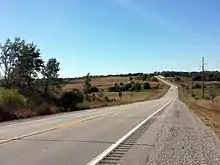
U.S. Highway 6 (US 6) is an east–west U.S. Highway which runs 319 miles (513 km) across the U.S. state of Iowa. The route is signed in places as the Grand Army of the Republic Highway. The route begins at the Missouri River crossing at Council Bluffs. From there, it travels east to Atlantic. North of Atlantic, the highway overlaps Interstate 80 (I-80) until De Soto. Between De Soto and Adel, the highway overlaps US 169 before splitting off to the east towards Des Moines, where it closely follows the I-35 / I-80 corridor. At Altoona, the route again overlaps I-80 until Newton, where it splits away. The highway passes near or through several more cities before entering the Coralville / Iowa City area. From Iowa City, the highway heads to the east-southeast. Near Wilton, the route heads north to I-80 where it again overlaps to Davenport. At Davenport, US 6 then follows I-280 and US 61 before entering the city. On the eastern side of Davenport, it joins I-74 and enters Bettendorf before leaving Iowa for Illinois. Dating back to 1910, the route US 6 follows was originally part of the Great White Way and River-to-River Road auto trails which connected Council Bluffs and Davenport. When the U.S. Highway System was created in 1926, the highway was designated U.S. Highway 32. US 32 was renumbered in 1931 to US 6. As the Interstate Highway System expanded in the 1950-1970s, US 6's importance as a cross-state route was diminished by I-80. As a result, some sections of the route were moved onto I-80.
Recently selected: Florida State Road 878 • Rhode Island Route 4 • Wendover Cut-off
June
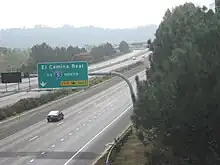
State Route 56 is an east–west state highway in the U.S. state of California. It runs 9.210 miles (14.822 km) from Interstate 5 (I-5) in the Carmel Valley neighborhood of San Diego to I-15 and the western end of the Ted Williams Parkway. SR 56 serves as an important connector between I-5 and I-15, being the only east–west freeway between SR 78 in north San Diego County, several miles away, and SR 52 near Marine Corps Air Station Miramar. It is also named the Ted Williams Freeway, after the San Diego-born baseball player. SR 56 was added to the state highway system in 1959 as Legislative Route 278, and was renumbered SR 56 in the 1964 state highway renumbering. Plans in 1964 were to connect SR 56 to the north end of SR 125 and continue east to SR 67, but these plans did not come to fruition. The eastern end from Black Mountain Road to I-15 was completed in 1993; the western end from I-5 to Carmel Creek Road was completed in 1995 after several lawsuits filed by the Sierra Club and other community groups. The two ends were not connected until the middle portion of the freeway was completed in 2004. The delay was largely due to funding issues and environmental concerns.
Recently selected: U.S. Route 6 in Iowa • Florida State Road 878 • Rhode Island Route 4
July

New York State Route 343 (NY 343) is a state highway located entirely within central Dutchess County, in the Hudson Valley region of the U.S. state of New York. It runs east–west from the intersection of NY 82 in the village of Millbrook to the Connecticut state line in the town of Amenia, where it continues eastward briefly as Connecticut Route 343. In Connecticut, Route 343 stretches for 1.50 miles (2.41 km) into the town of Sharon, Connecticut, where it terminates at a junction with Route 4 and Route 41. Along the way, NY 343 has a 7.3-mile (11.7 km) concurrency with NY 22 from vicinity of the hamlet of Dover Plains to the hamlet of Amenia. The entirety of modern Route 343 was originally the Dover branch of the Dutchess Turnpike, which was in operation from the early to the mid-19th century. NY 343 was designated in 1930, connecting the hamlet of Amenia to the state line, but was relocated a few years later onto the portion of New York State Route 200 from South Millbrook to the hamlet of Dover Plains. The NY 200 designation was transferred to NY 343's original alignment. NY 343 absorbed NY 200 in the early 1940s, creating an overlap with NY 22 between Dover Plains and Amenia. The Connecticut portion of the highway was originally designated as part of Route 4; however, it was renumbered to Route 343 in 1932.
Recently selected: California State Route 56 • U.S. Route 6 in Iowa • Florida State Road 878
August
Virginia State Route 253 (SR 253) is a primary state highway in the U.S. state of Virginia. Known as Port Republic Road, the state highway runs 12.18 miles (19.60 km) from U.S. Route 11 (US 11) in Harrisonburg east to US 340 near Port Republic. SR 253 is a northwest–southeast highway that connects Harrisonburg with Cross Keys and Port Republic in southeastern Rockingham County. The state highway also provides access to portions of James Madison University on either side of Interstate 81 (I-81). A small portion of Port Republic Road through Port Republic was included in the state highway system by the late 1920s as part of the highway between Waynesboro and Elkton. This section carried three different route numbers until it was transferred to the secondary system in the early 1940s. Port Republic Road was placed on its modern alignment through Port Republic in the mid-1950s. SR 659, which was assigned to Port Republic Road from Harrisonburg to near Cross Keys, was extended southeast through Port Republic by the mid-1970s. The road was expanded to four lanes within Harrisonburg in the mid-1990s and mid-2000s and along a short stretch south from the city limits in the early 2010s. SR 659 was brought into the primary highway system as SR 253 in 2005.
Recently selected: New York State Route 343 • California State Route 56 • U.S. Route 6 in Iowa
September
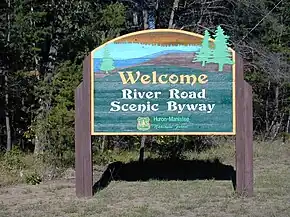
The River Road National Scenic Byway (also called the River Road National Forest Scenic Byway) is a National Scenic Byway and National Forest Scenic Byway in the US state of Michigan. This 23+1⁄2-mile-long (37.8 km) byway follows M-65 and River Road; it extends eastward into the Huron National Forest and ends in the historic community of Oscoda near Lake Huron. The road parallels the historic Au Sable River (French: Rivière aux Sable, "River of Sand") which has historically been a major transportation route for floating Michigan’s giant white pine from the forest to the saw mill towns on Lake Huron. Along its course, the roadway offers access to several recreational areas as well as the local scenery. The section of the River Road that follows M-65 was added to the State Trunkline Highway System in the 1930s. The River Road was given National Forest Scenic Byway status in 1988, and National Scenic Byway status in 2005.
Recently selected: Virginia State Route 253 • New York State Route 343 • California State Route 56
October
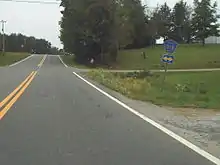
State Route 73, also known as SR-73, is a numbered state highway in Alabama. The route runs 11.219 miles (18.055 km) from SR-71 in Higdon north to the Tennessee border, where it becomes State Route 377 (SR-377). SR-73 passes through rural areas in eastern Jackson County, serving the community of Bryant. The SR-73 designation was first used for present-day CR-29 between Piedmont in Calhoun County and Forney in Cherokee County, existing in the 1930s and 1940s. In the 1950s, SR-207 was briefly assigned to the road between Higdon and Bryant before it received the SR-73 designation. SR-73 was extended in the 1980s north to the Tennessee state line to connect to SR-377.
Recently selected: River Road National Scenic Byway • Virginia State Route 253 • New York State Route 343
November
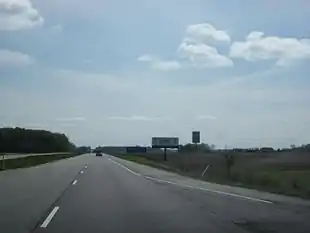
U.S. Route 30 (US 30) is a road in the United States Numbered Highway System that runs from Astoria, Oregon to Atlantic City, New Jersey. In Indiana, the route runs from the Illinois state line at Dyer to the Ohio state line east of Fort Wayne and New Haven. The 155.96 miles (250.99 km) of US 30 that lie within Indiana serve as a major conduit. The entire length of U.S. Route 30 in Indiana is included in the National Highway System (NHS). The highway includes four-lane, rural sections, an urbanized, four-lane divided expressway, and several high-traffic, six-lane areas. First designated as a US Highway in 1926, US 30 replaced the original State Road 2 (SR 2) and SR 44 designation of the highway which dated back to the formation of the Indiana State Road system. A section of the highway originally served as part of the Lincoln Highway. Realignment and construction projects have expanded the highway to four lanes across the state.
Recently selected: Alabama State Route 73 • River Road National Scenic Byway • Virginia State Route 253
December

Interstate 895 (I-895) is an Interstate Highway in the U.S. state of Maryland. Known as the Harbor Tunnel Thruway, the highway runs 14.87 miles (23.93 km) between one junction with I-95 in Elkridge and another interchange with I-95 on the east side of Baltimore. I-895 is a toll road that crosses the Patapsco River estuary via the Baltimore Harbor Tunnel. The highway is designed for through traffic by having partial interchanges that require vehicles from almost all starting points to pass through the tunnel and the tunnel toll plaza, where a $3 toll is charged to passenger vehicles, before exiting the facility. The idea of a crossing of the Patapsco River south of downtown Baltimore has been studied since the 1930s. In the early 1950s, the Maryland State Roads Commission chose to construct a four-lane tunnel between the Canton and Fairfield neighborhoods of Baltimore and approach highways. The tunnel and approach highways were constructed beginning in 1955 and opened in November 1957, opening a bottleneck for Baltimore through traffic. The Harbor Tunnel Thruway was connected with the John F. Kennedy Memorial Highway in the early 1960s and the portion of I-95 south to Washington in the early 1970s and became congested. The congestion was not resolved until I-95 through Baltimore was completed when the eight-lane Fort McHenry Tunnel opened in November 1985. The transfer of most traffic to the new tunnel allowed the Baltimore Harbor Tunnel to be partially shut down for extensive maintenance in the late 1980s.
Recently selected: U.S. Route 30 in Indiana • Alabama State Route 73 • River Road National Scenic Byway
2015
January
.jpg.webp)
Oregon Route 120 (OR 120) is a 2.71-mile-long (4.36 km) unsigned state highway in the U.S. state of Oregon. The highway is internally known by the Oregon Department of Transportation (ODOT) as Swift Highway No. 120. OR 120 runs from a Union Pacific railroad crossing near North Columbia Boulevard to an interchange with Interstate 5 (I-5) and OR 99E. The Swift Highway No. 120 was created in 1931 while the OR 120 designation was created in 2002.
Recently selected: Interstate 895 (Maryland) • U.S. Route 30 in Indiana • Alabama State Route 73
February

Minnesota State Highway 7, or Trunk Highway 7, (MN 7, TH 7) is a state highway in Minnesota, which runs from its intersection with MN 28 near Beardsley and continues east to its terminus with MN 100 and County Road 25 (CR 25) in St. Louis Park. The highway runs east–west for approximately 194.2 miles (312.5 km) through mostly rural farmland in the central part of the state. On its western end, it is part of the Minnesota River Scenic Byway where it runs northwest–southeast along the Minnesota River and associated lakes near the border with the adjoining state of South Dakota. For roughly 24 miles (39 km) of its route, it runs concurrently with U.S. Highway 59 (US 59) between Appleton and Montevideo. In Montevideo, the highway turns to the east cutting across the state. It passes through several small towns before entering the Twin Cities metropolitan area. In the metro area, MN 7 follows an expressway through several suburbs before terminating in St. Louis Park. Two different segments have been listed on the National Highway System, system of roads considered important to the country. The highway was first designated between Appleton and Minneapolis around 1933. Within the first year or so, the western end was extended to terminate MN 7 in the Ortonville area. In 1958, the highway was extended to its modern western terminus at Beardsley by replacing another trunk highway. The section that is now an expressway in the Twin Cities was expanded by the 1950s. The highway was truncated in the Twin Cities to its current eastern terminus in the 1980s. The scenic byways designations were applied at the state and federal levels in 1995 and 2002, respectively.
Recently selected: Oregon Route 120 • Interstate 895 (Maryland) • U.S. Route 30 in Indiana
March

Interstate 8 (I-8) is an Interstate Highway in the southwestern United States. It runs from the southern edge of Mission Bay at Sunset Cliffs Boulevard, in San Diego, California, almost at the Pacific Ocean, to the junction with I-10, just southeast of Casa Grande, Arizona. In California, the freeway travels through the San Diego metropolitan area as the Ocean Beach Freeway and the Mission Valley Freeway before traversing the Cuyamaca Mountains and providing access through the Imperial Valley, including the city of El Centro. Crossing the Colorado River into Arizona, I-8 continues through the city of Yuma across the Sonoran Desert to Casa Grande, in between the cities of Phoenix and Tucson.
The first route over the Cuyamaca Mountains was dedicated in 1912, and a plank road served as the first road across the Imperial Valley to Yuma; east of there, the Gila Trail continued east to Gila Bend. These were later replaced by U.S. Route 80 (US 80) across California and part of Arizona, and Arizona State Route 84 (SR 84) between Gila Bend and Casa Grande. The US 80 freeway through San Diego was largely complete by the time it was renumbered as I-8 in 1964; east of San Diego, the US 80 roadway was slowly replaced by I-8 as construction progressed in the Imperial Valley. The Arizona portion of the road was built starting in the 1960s. Several controversies erupted during the construction process. The route was completed in 1975 through California, and by 1977 through Arizona, though the bridge over the Colorado River was not completed until 1978. Since then, the freeway through San Diego has been widened due to increasing congestion, and another portion in Imperial County had to be rebuilt following Tropical Storm Kathleen.
Recently selected: Minnesota State Highway 7 • Oregon Route 120 • Interstate 895 (Maryland)
April

Interstate 470 (I-470) is a 13.72-mile (22.08 km) loop highway that bypasses the downtown area of Topeka, Kansas. I-470 begins at an interchange with Interstate 70 in western Topeka and heads generally southeast, running concurrent with U.S. Route 75 (US-75). The concurrency with US-75 ends 5.74 miles (9.24 km) later at the Burlingame Road interchange. I-470 becomes part of the Kansas Turnpike at its junction with Interstate 335. From there, the highway heads generally northeast through the southeastern sections of Topeka. After traveling 7.03 miles (11.31 km) as the Kansas Turnpike, I-470 reaches its eastern terminus with Interstate 70. The Kansas Turnpike was opened in the 1950s, comprising the eastern portion of the route. In the late 1950s construction began on the western portion of I-470, and on October 21, 1960, the western section of I-470 was dedicated and opened to traffic. In 1982, Interstate 470 was designated as "Martin Luther King Jr. Memorial Highway". The routing of I-470 has not changed since the completion of the highway.
Recently selected: Interstate 8 • Minnesota State Highway 7 • Oregon Route 120
May
_map%252C_cropped.jpg.webp)
The Bay Freeway, also referred to as the Mercer Street Connection, was a proposed elevated freeway in the South Lake Union neighborhood of Seattle, Washington, replacing 0.7 miles (1.1 km) of Mercer Street between Interstate 5 (I-5) and Aurora Avenue North at the Seattle Center. Planning for the freeway began in 1954, with the proposal for a freeway from Elliott Bay to the Central Freeway, later I-5, via Broad and Mercer streets added to the city's comprehensive plan in 1957. Funded by a bond measure passed by Seattle voters in 1960, plans for the newly christened and elevated Bay Freeway to serve a multi-purpose stadium at the Seattle Center were opposed by citizens groups at public hearings in 1967, forcing the Seattle Engineering Department to consider other designs. After determining that a cut-and-cover tunnel would not be feasible, a second series of public hearings were held in 1970, leading to widespread controversy and a civil suit launched in opposition to the freeway. The lawsuit ended in November 1971, with King County Superior Court Judge Solie M. Ringold ruling that it was a major deviation from the voter-approved 1960 plan, forcing a referendum to continue on with the project. On February 8, 1972, the Bay Freeway project was rejected by a 10,000-vote margin in a municipal referendum, alongside the repeal of the R.H. Thomson Expressway, postponing congestion relief on Mercer Street until the Mercer Corridor Project in 2012.
Recently selected: Interstate 470 (Kansas) • Interstate 8 • Minnesota State Highway 7
June

State Route 161 (SR 161) is an east–west state highway in central Ohio. Its western terminus is in Mutual at State Route 29 and its eastern terminus is near Alexandria at State Route 37. It is 57.46 miles (92.47 km) long. State Route 161 passes through Columbus, Ohio's capital, and a variety of towns including Plain City, Dublin, and New Albany. The route was established in 1924 to connect Plain City and Dublin. It was later expanded to cover Mutual and Granville. Parts of SR 161 in Dublin and New Albany were upgraded to a freeway in 1969 and 1997.
Recently selected: Bay Freeway (Seattle) • Interstate 470 (Kansas) • Interstate 8
July
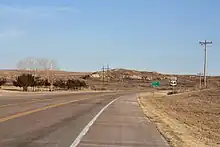
U.S. Route 64 (US-64) is a U.S. highway that passes through the state of Oklahoma for a total of 591.17 miles (951.40 km). US-64 enters the state from New Mexico, crossing the line between the two states between Clayton, New Mexico, and Boise City in Cimarron County. The route runs the full length of the Oklahoma Panhandle, then serves the northernmost tier of counties in the main body of the state before dipping southeastward to Tulsa, the state's second-largest city. From Tulsa, the highway continues southeast, leaving Oklahoma just west of Fort Smith, Arkansas. In addition to Tulsa, US-64 serves fifteen Oklahoma counties and the cities of Guymon, Woodward, Enid, and Muskogee. US-64 has been a part of the United States Numbered Highways system from the program's inception in 1926. US-64's route has remained roughly the same since then, although it has undergone alterations several times, many changing its course through towns and moving the highway designation to higher-capacity expressways and freeways.
Recently selected: Ohio State Route 161 • Bay Freeway (Seattle) • Interstate 470 (Kansas)
August

The Delaware State Route System consists of roads in the U.S. state of Delaware that are maintained by the Delaware Department of Transportation (DelDOT). The system includes the portions of the Interstate Highway System and United States Numbered Highways system located in the state along with state routes and other roads maintained by DelDOT. All roads maintained by the state are assigned an internal maintenance road number. DelDOT maintains a total of 5,386.14 miles (8,668.15 km) of roads, comprising 89 percent of the roads within the state. Some large bridges in the state are maintained by other agencies including the U.S. Army Corps of Engineers and the Delaware River and Bay Authority. Roads in the system include multilane freeways, multilane surface divided highways, and two-lane undivided roads serving urban, suburban, and rural areas. Some of the roads maintained by DelDOT are toll roads. The first roads in Delaware were Native American trails and unpaved roads laid out by colonial Swedish and English settlers. From this time, counties were responsible for roads. In the 19th century, private companies operated several turnpikes radiating from Wilmington. Thomas Coleman DuPont proposed a modern road in 1908 to run the north-south length of the state; this road evolved into the DuPont Highway that was completed in 1923. The Delaware State Highway Department was formed on April 2, 1917 to construct a state highway system in Delaware. Numbered routes came with the creation of the U.S. Highway System in 1926; state route numbers appeared 10 years later. In 1935, the state took over the remaining county roads. In the middle part of the 20th century, several major roads were widened into divided highways. The creation of the Interstate Highway System in 1956 led to the construction of 40 miles (64 km) of freeway in northern New Castle County, including the tolled Delaware Turnpike. The Delaware Route 1 limited-access toll road between Dover and Wilmington was fully completed in 2003.
Recently selected: U.S. Route 64 in Oklahoma • Ohio State Route 161 • Bay Freeway (Seattle)
September
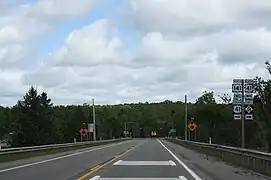
US Highway 141 (US 141) is a north–south United States Numbered Highway in the states of Wisconsin and Michigan. The highway runs north-northwesterly from an interchange with Interstate 43 (I-43) in Bellevue, Wisconsin, near Green Bay, to a junction with US 41/M-28 near Covington, Michigan. In between, it follows city streets in Green Bay and has a concurrent section with US 41 in Wisconsin. North of Green Bay, US 141 is either a freeway or an expressway into rural northern Wisconsin before downgrading to an undivided highway. In Michigan, US 141 is an undivided highway. The highway has two segments in each state; after running through Wisconsin, it crosses into Michigan for approximately another 8 miles (13 km). After that, it crosses back into Wisconsin for about 14+1⁄2 miles (23 km) before crossing the state line one last time. The total length of the route is about 169 miles (272 km). When the US Highway System was formed on November 11, 1926, US 141 ran from Milwaukee to Green Bay, and one segment of the modern highway in Michigan was originally designated US 102. This other designation was decommissioned in 1928 when US 141 was extended north from Green Bay into Michigan. Michigan has rebuilt the highway in stages over the years to smooth out sharp curves in the routing. Since the 1960s, the section south of Green Bay has been converted into a freeway in segments. US 141 has ended southeast of Green Bay in Bellevue since the 1980s—the southern freeway segment was redesignated as I-43. The section north of Abrams, Wisconsin, was converted to a freeway in the opening years of the 21st century, with an additional divided-highway section opening a few years later.
Recently selected: Delaware State Route System • U.S. Route 64 in Oklahoma • Ohio State Route 161
October
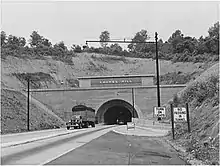
The Pennsylvania Turnpike is a toll highway in the U.S. state of Pennsylvania. A controlled-access highway, it runs for 360 miles (580 km) across the state. The turnpike begins at the Ohio state line in Lawrence County, where the road continues west into Ohio as the Ohio Turnpike. It ends at the New Jersey border at the Delaware River–Turnpike Toll Bridge over the Delaware River in Bucks County, where it continues east as the Pearl Harbor Memorial Extension of the New Jersey Turnpike. The highway runs east–west through the state, connecting the Pittsburgh, Harrisburg, and Philadelphia areas. It crosses the Appalachian Mountains in central Pennsylvania through four tunnels. The turnpike is part of the Interstate Highway System; it is designated as part of Interstate 76 (I-76) between the Ohio border and Valley Forge, I-70 and I-76 between New Stanton and Breezewood, and I-276 between Valley Forge and the New Jersey border. The road uses a ticket system of tolling between the Warrendale and Delaware River Bridge toll plazas. An additional eastbound toll plaza is located at Gateway, near the Ohio border. E-ZPass, a form of electronic toll collection, is accepted at all toll plazas. During the 1930s the Pennsylvania Turnpike was designed to improve automobile transportation across the mountains of Pennsylvania, using seven tunnels built for the abandoned South Pennsylvania Railroad in the 1880s. The road opened on October 1, 1940 between Irwin and Carlisle as the first long-distance limited-access highway in the United States. The turnpike was extended east to Valley Forge in 1950 and west to the Ohio border in 1951. In 1954, the road was extended further east to the Delaware River. The mainline turnpike was finished in 1956 with the completion of the Delaware River Bridge. During the 1960s an additional tube was bored at four of the two-lane tunnels, while the other three tunnels were bypassed. Improvements continue to be made to the road.
Recently selected: U.S. Route 141 • Delaware State Route System • U.S. Route 64 in Oklahoma
November
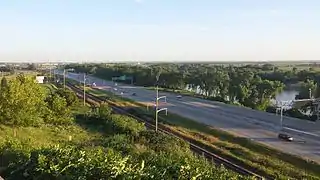
In the U.S. state of Iowa, Interstate 29 (I-29) is a north–south Interstate Highway which closely parallels the Missouri River. I-29 enters Iowa from Missouri near Hamburg and heads to the north-northwest through the Omaha-Council Bluffs and the Sioux City areas. It exits the state by crossing the Big Sioux River into South Dakota. For its entire distance through the state, it runs on the flat land between the Missouri River and the Loess Hills. I-29 was built in sections over a period of 15 years. When there was a shortage of male workers, female workers stepped in to build a twenty-mile (32 km) section near Missouri Valley. Between Council Bluffs and Sioux City, I-29 replaced U.S. Route 75 (US 75) as the major route in western Iowa. As a result of I-29's creation, US 75 south of Sioux City was relocated into Nebraska.
Recently selected: Pennsylvania Turnpike • U.S. Route 141 • Delaware State Route System
December
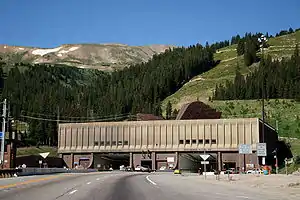
The Eisenhower Tunnel, officially the Eisenhower–Johnson Memorial Tunnel, is a dual-bore, four-lane vehicular tunnel approximately 50 mi (80 km) west of Denver, Colorado, United States. The tunnel carries Interstate 70 under the Continental Divide in the Rocky Mountains. With a maximum elevation of 11,158 ft (3,401 m) above sea level, it is one of the highest vehicular tunnels in the world. The tunnel is the longest mountain tunnel and highest point on the Interstate Highway system. Completed in 1979, it was one of the last major pieces of the Interstate Highway system to be completed. The westbound bore is named after Dwight D. Eisenhower, the U.S. President for whom the Interstate system is also named. The eastbound bore is named for Edwin C. Johnson, a governor and U.S. Senator who lobbied for an Interstate Highway to be built across Colorado.
Recently selected: Interstate 29 in Iowa • Pennsylvania Turnpike • U.S. Route 141
2016
January
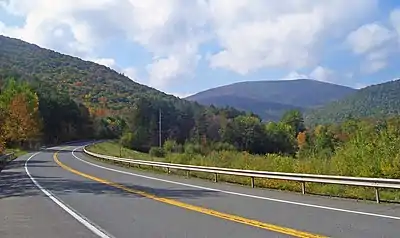
New York State Route 28 (NY 28) is a state highway extending for 281.69 miles (453.34 km) in the shape of a "C" between the Hudson Valley city of Kingston and southern Warren County in the U.S. state of New York. Along the way, it intersects several major routes, including Interstate 88 (I-88), U.S. Route 20 (US 20), and the New York State Thruway twice. The southern terminus of NY 28 is at NY 32 in Kingston and the northern terminus is at US 9 in Warrensburg. In Kingston, NY 28 is co-designated asInterstate 587 from its southern terminus at NY 32 to the roundabout linking it to the Thruway (I-87). NY 28 was originally assigned in 1924 to an alignment extending from Colliersville in the south to Utica in the north via Ilion. From Colliersville to Cooperstown, the highway followed its current routing (excluding minor realignments); north of Cooperstown, NY 28 was routed along several state highways that now have other designations. The route was extended south to Kingston and north to Warrensburg as part of the 1930 renumbering of state highways in New York. At the same time, NY 28 was realigned between Cooperstown and Mohawk to follow its modern routing. Other than minor realignments in Kingston, Oneonta, and Oneida County, NY 28 has remained the same to this day.
Recently selected: Eisenhower Tunnel • Interstate 29 in Iowa • Pennsylvania Turnpike
February

State Route 67 (SR 67) is a state highway in San Diego County, California. It begins at Interstate 8 (I-8) in El Cajon and continues to Lakeside as the San Vicente Freeway before becoming an undivided highway through the eastern part of Poway. In the town of Ramona, the route turns into Main Street before ending at SR 78. SR 67 provides direct access from the city of San Diego to the East County region of San Diego County, including Ramona and Julian. The route has existed as a railroad corridor since the turn of the 20th century. A highway known as the Julian road was built by 1913, and was designated as Legislative Route 198 in the state highway system by 1935. Route 198 was renumbered SR 67 in the 1964 state highway renumbering. A freeway south of Lakeside was built in the late 1960s, and opened to traffic in 1970. Since then, the portion of the highway north of Lakeside has become known for a high number of traffic accidents and related fatalities. The California Department of Transportation (Caltrans) has made several attempts to remedy the problem and make the road safer.
Recently selected: New York State Route 28 • Eisenhower Tunnel • Interstate 29 in Iowa
March

U.S. Route 15 (US 15) is a part of the U.S. Highway System in Maryland that runs 37.85 miles (60.91 km) from the Virginia state line at the Potomac River in Point of Rocks north to the Pennsylvania state line near Emmitsburg. Known for most of its length as Catoctin Mountain Highway, US 15 is the primary north–south highway of Frederick County. The highway connects the county seat of Frederick with Point of Rocks to the south and with Thurmont and Emmitsburg to the north. US 15 is a four-lane divided highway throughout most of the state. The U.S. Highway is a freeway along its concurrency with US 340 and through Frederick, where the highway meets US 40 and Interstate 70 (I-70). US 15 is the descendent of a pair of turnpikes that connected Frederick with Emmitsburg to the north and Buckeystown to the south. These turnpikes were reconstructed as state roads in the 1910s north of Frederick and in the early 1920s from Frederick south to Tuscarora. When US 15 was assigned in 1927, the Tuscarora – Point of Rocks highway had yet to be improved; this section was paved in the early 1930s. The modern Point of Rocks Bridge was built in the late 1930s after its predecessor was destroyed in a flood. The Frederick Freeway was constructed in the 1950s. US 15 was relocated to part of the freeway; the old route through downtown Frederick became part of Maryland Route 355 (MD 355). US 15's present highway between Point of Rocks and Jefferson was constructed in the late 1960s; the old road south of Frederick was replaced with MD 28 and MD 85. North of Frederick, the U.S. Highway bypassed Thurmont and Emmitsburg in the late 1950s and mid-1960s, respectively. US 15 was upgraded to a divided highway north of Frederick in the early 1980s.
Recently selected: California State Route 67 • New York State Route 28 • Eisenhower Tunnel
April
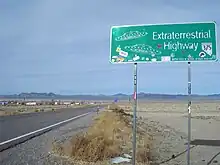
State Route 375 (SR 375) is a state highway in south-central Nevada in the United States. The highway stretches 98 miles (158 km) from State Route 318 at Crystal Springs northwest to U.S. Route 6 (US 6) at Warm Springs. The route travels through mostly unoccupied desert terrain, with much of its alignment paralleling the northern edges of the Nellis Air Force Range. The road originally traversed through what is now the northern reaches of the air force range in the 1930s, when it was previously designated State Route 25A and later part of State Route 25. The top-secret Area 51 government base is near SR 375 and many travelers have reported UFO observations and other strange alien activity along this road. Such stories prompted the state to officially designate the route as the Extraterrestrial Highway in 1996. The small town of Rachel, located near the center of the highway, caters to tourists, Geocachers, and UFO seekers with alien-themed businesses. Although the area receives some tourism due to alleged extraterrestrial activity, SR 375 remains a lightly traveled route.
Recently selected: U.S. Route 15 in Maryland • California State Route 67 • New York State Route 28
May

H-58 is a county-designated highway that runs east–west for approximately 69 miles (111 km) between the communities of Munising and Deer Park in the Upper Peninsula. The western section is routed through Pictured Rocks National Lakeshore, a national park on the southern shore of Lake Superior, and the adjacent Lake Superior State Forest in Alger County. At Grand Marais, H-58 exits the national park and runs through town. The segment running east of Grand Marais to Deer Park in Luce County is a gravel road that connects to H-37 in Muskallonge Lake State Park. A roadway was present along parts of today's H-58 by the late 1920s; initially, this county road was gravel or earth between Munising and Kingston Corners and connected with other roads to Grand Marais. The H-58 designation was created after the county-designated highway system itself was formed in 1970. Initially, only the section from Grand Marais to Deer Park was given the number; the remainder was added in 1972. The last sections to be paved in the 20th century were completed in 1974. The National Park Service was required to build their own access road for the Pictured Rocks National Lakeshore in the initial legislation that created the park. This requirement was rescinded by the United States Congress in 1998, and the park service was authorized to fund improvements to H-58 instead. Paving projects were completed between 2006 and 2010 so that the entire length of H-58 in Alger County is now paved; the section in Luce County is still a gravel road.
Recently selected: Nevada State Route 375 • U.S. Route 15 in Maryland • California State Route 67
June
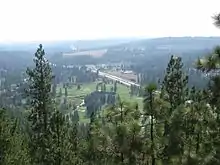
U.S. Route 195 (US 195) is a north–south United States Highway, of which all but 0.65 miles of its 94.42 miles (1.05 of 151.95 km) are within the state of Washington. The highway starts in rural Idaho north of the city of Lewiston at an interchange with US 95. The road crosses into Washington and connects communities in the Palouse region of Eastern Washington. US 195 travels north, serving the cities of Pullman, Colfax and Rosalia in Whitman County before continuing into Spokane County to its terminus in the city of Spokane at an interchange with Interstate 90 (I-90). The first section of US 195 designated as part of Washington's state highway system was codified in 1913 from Colfax to Spokane as the Inland Empire Highway and from the Idaho state line to Pullman as the Second Division of the Eastern Route of the Inland Empire Highway. The two highways were included as part of State Road 3 in 1923 and US 195 during the creation of the US Highway System on November 11, 1926. Originally, the northern terminus of the highway was at US 95 in Sandpoint, but was truncated to Spokane after US 2 was extended west from Bonners Ferry in 1946. US 195 was cosigned with Primary State Highway 3 (PSH 3) from US 95 to Spokane and PSH 6 from Spokane to Newport from 1937 until the 1964 highway renumbering. US 195 was extended south into Idaho after the relocation of US 95, designated as the North and South Highway in 1916, onto its present freeway in 1975. Bypasses of Pullman, Rosalia, and Plaza were completed during the early 1970s, converting portions of US 195 into a divided highway.
Recently selected: H-58 (Michigan county highway) • Nevada State Route 375 • U.S. Route 15 in Maryland
July

Legacy Parkway (designated as State Route 67, SR-67) is an 11.5-mile-long (18.5 km) four-lane controlled-access parkway located almost completely within Davis County in the northern part of the U.S. state of Utah. The parkway travels north from Interstate 215 (I-215) in northwestern Salt Lake City to an interchange named the Wasatch Weave in Farmington with two intermediate interchanges providing access to Woods Cross and Centerville. Wetlands of the nearby Great Salt Lake and nature preserves border the western side of the parkway while the eastern side roughly parallels Union Pacific and Utah Transit Authority rail lines and I-15. Construction began in 2006 and was completed in 2008, with the parkway opening in September of the same year. The parkway was controversial in its construction and was challenged in court several times before a compromise was met between the state and the Sierra Club, which limited the speed on the road and banned trucks on the highway except in emergencies. In addition to the restrictions on speed and trucks, the road was reduced from a six-lane expressway to a four-lane parkway. On average, between 20,000 and 23,000 vehicles use the parkway daily.
Recently selected: U.S. Route 195 • H-58 (Michigan county highway) • Nevada State Route 375
August

North Carolina Highway 54 (NC 54) is a 55-mile-long (89 km) primary state highway in the U.S. state of North Carolina. The highway serves the Research Triangle area, between Burlington and Raleigh, connecting the cities and towns of Chapel Hill, Durham, Morrisville and Cary. NC 54 runs from U.S. Highway 70 (US 70) in Burlington through the downtown area of Graham. Turning to the southeast the route runs through some of the outskirts of Burlington before moving through a predominantly rural area. Approaching Chapel Hill, the highway bypasses town and runs concurrently with US 15/US 501. From here, NC 54 continues to the east crossing Interstate 40 (I-40) and running through the outskirts of Durham. The road continues to follow I-40 as it enters into Research Triangle Park and Morrisville. NC 54 reaches the downtown area of Cary where it heads onto a bypass. On the eastern side of Cary, NC 54 continues east to Raleigh, where it runs through west Raleigh and along the NC State Fairgrounds. The highway ends at I-440/US 1 west of downtown Raleigh. NC 54 first appeared as an original state highway running from NC 75 in Pittsboro to Moncure. However by 1928 the route was recommissioned as a secondary road which remains today as Moncure Pittsboro Road. The current NC 54 was signed in 1929 from Graham to US 70 south of Durham. In 1930 it was further extended through Rockingham to the Virginia border, however in 1940 much of that routing was renumbered as NC 87. The route was further extended in 1953 where it ran concurrent along US 70A until reaching US 1 in Cary. The Chapel Hill Bypass was completed in 1956 and NC 56 was rerouted from its downtown Chapel Hill routing to the new bypass. The last major change to the routing occurred in 1963 when NC 54 was extended along Hillsbourgh Street to the new US 1 freeway (present day I-440).
Recently selected: Legacy Parkway • U.S. Route 195 • H-58 (Michigan county highway)
September
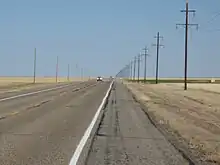
U.S. Route 412 (abbreviated US-412) is a U.S. highway in the south-central portion of the United States, connecting Springer, New Mexico to Columbia, Tennessee. A 504.11-mile (811.29 km) section of the highway crosses the state of Oklahoma, traversing the state from west to east. Entering the state southwest of Boise City, US-412 runs the length of the Oklahoma Panhandle and serves the northern portion of the state's main body, before leaving the state at West Siloam Springs. Along the way, the route serves many notable cities and towns, including Boise City, Guymon, Woodward, Enid, and the state's second-largest city, Tulsa. US-412 has two tolled sections—the Cimarron Turnpike and the Cherokee Turnpike. The tolled portions of the highway are operated by the Oklahoma Turnpike Authority (OTA), with the remainder of the route maintained by the Oklahoma Department of Transportation (ODOT). In addition to the freeway-grade turnpikes, a large amount of the highway has been upgraded to four-lane expressway facilities, although some portions remain two-lane, especially in the Panhandle. Much of US-412's route through Oklahoma either overlaps or is in close proximity to that of US-64. US-412 was extended into Oklahoma in 1988 to encourage recreational travel and the resulting economic benefit to the state. This extension, in which the new designation replaced or overlapped several already existing highways, brought US-412's western terminus to Woodward. In 1993, it was extended west of Oklahoma, bringing it through the Panhandle and into New Mexico.
Recently selected: North Carolina Highway 54 • Legacy Parkway • U.S. Route 195
October
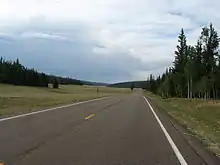
State Route 67 (SR 67) is a 43.4 mi (69.8 km) long, north–south state highway in northern Arizona. Also called the Kaibab Plateau – North Rim Parkway, SR 67 is the sole road that links U.S. Route 89A (US 89A) at Jacob Lake to the North Rim of Grand Canyon National Park. Along the route, the road heads through the national park as well as Kaibab National Forest and is surrounded by evergreen trees. The section inside the national park is maintained by the National Park Service (NPS), whereas the section north of the entrance, completely within Kaibab National Forest, is owned by the Arizona Department of Transportation (ADOT). The road was built in the late 1920s and improved through the 1930s. In 1941, the road received its number, and was given its designation as the parkway in the 1980s. The parkway has received designations as a National Forest Scenic Byway as well as a National Scenic Byway.
Recently selected: U.S. Route 412 in Oklahoma • North Carolina Highway 54 • Legacy Parkway
November

In the U.S. state of West Virginia, Interstate 81 (I-81) crosses the Eastern Panhandle region, linking Virginia to Maryland. The Interstate Highway, completed in 1966, spans 26.00 miles (41.84 km) through Berkeley County, paralleling U.S. Route 11 (US 11) for its entire length. I-81 enters the state near Ridgeway and travels northeast, bypassing the city of Martinsburg, and leaves the state at the Potomac River, which serves as the state line. The first solicitations for the construction of I-81 were published in 1959, with the first 6 miles (9.7 km) of freeway being opened in 1963, and the full length was completed by 1966. On average between 45 and 60 thousand vehicles use the freeway though the panhandle per day.
Recently selected: Arizona State Route 67 • U.S. Route 412 in Oklahoma • North Carolina Highway 54
December

U.S. Highway 67 (US 67) is a U.S. Highway in extreme eastern Iowa. The route begins in Davenport at the Rock Island Centennial Bridge where it crosses the Mississippi River and ends at an intersection with US 52 and Iowa Highway 64 (Iowa 64) west of Sabula. It passes through Bettendorf, Le Claire, and Clinton. Except for Folletts, every community which US 67 enters sits along the Mississippi River. As such, the entire route is part of the Great River Road, an All-American Road. US 67 was created in late 1934, when it replaced US 55 from Davenport to Dubuque. The route ended then at the foot of the Julien Dubuque Bridge, which carries US 20. The northern half of the route, from Sabula to Dubuque, was overlapped by US 52 until 1967. Most of the state highways that intersect US 67 do so within sight of their Mississippi River bridge crossing.
Recently selected: Interstate 81 in West Virginia • Arizona State Route 67 • U.S. Route 412 in Oklahoma
2017
January

State Route 94 (SR 94) is a highway in the U.S. state of California that is 63.324 miles (101.910 km) long. The western portion, known as the Martin Luther King Jr. Freeway, begins at Interstate 5 (I-5) in downtown San Diego and continues to the end of the freeway portion past SR 125 in Spring Valley. The non-freeway segment of SR 94 that continues east through the mountains to I-8 near Boulevard is known as Campo Road. The Campo road served as a wagon road providing access to eastern San Diego County as well as Imperial County. The road was added to the state highway system in 1933, and signs for Route 94 were posted along local roads later that decade. Efforts to convert the western half of the route to a freeway got underway in the 1950s, and the freeway was complete by 1962 west of the road that became SR 125. Construction continued east to Avocado Road over the next few years. Various proposals for widening the highway have come from the California Department of Transportation (Caltrans), but local opposition resulted in the delay or cancellation of many of these proposals.
Recently selected: U.S. Route 67 in Iowa • Interstate 81 in West Virginia • Arizona State Route 67
February
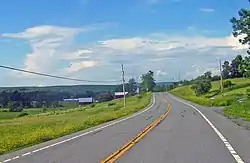
New York State Route 32 (NY 32) is a north–south state highway that extends for 176.73 miles (284.42 km) through the Hudson Valley and Capital District regions of the U.S. state of New York. It is a two-lane surface road for nearly its entire length, with few divided and no limited-access sections. From Harriman to Albany, it is closely parallel to Interstate 87 (I-87) and U.S. Route 9W (US 9W), overlapping with the latter in several places. NY 32 begins at NY 17 on the outskirts of the New York metropolitan area in Woodbury just outside Harriman, and ends at NY 196 east of Hudson Falls just south of the Adirondacks. In between, the road passes through the cities of Newburgh, Kingston, Albany, Cohoes, and Glens Falls. Outside of the cities, it offers views of the Hudson Highlands, Shawangunk Ridge, Catskill Mountains, and, during an overlap with US 4 north of Albany, the Hudson River. The roads now making up the highway were originally part of several privately maintained turnpikes, which fostered settlements along the corridor. Once part of the former NY 58, it has been NY 32 since 1930. Only one of three letter-suffixed spur routes remains.
Recently selected: California State Route 94 • U.S. Route 67 in Iowa • Interstate 81 in West Virginia
March
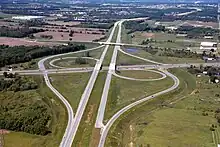
M-6, or the Paul B. Henry Freeway, is a 19.696-mile (31.698 km) freeway that serves portions of southern Kent and eastern Ottawa counties south of Grand Rapids. The freeway is named for Paul B. Henry, a congressman who died in office representing the area. The freeway connects Interstate 196 (I-196) on the west to I-96 on the east while running through the south side of the Grand Rapids metropolitan area in Western Michigan. Each end is in a rural area while the central section has suburban development along the freeway near the connection to US Highway 131. The freeway was originally conceived in the 1960s. It took 32 years to plan, finance, and build the freeway from the time that the state first authorized funding in 1972 until the South Beltline opened to traffic in November 2004. Initial construction started in November 1997, with the first phase opened in November 2001. The first phase of construction was completed in asphalt, while the second and third phases were built in concrete, costing a total of $700 million. The project was built with two firsts: the first single-point urban interchange in Michigan, and a new technique to apply the pavement markings, embedding them into the concrete to reduce the chance of a snowplow scraping them off.
Recently selected: New York State Route 32 • California State Route 94 • U.S. Route 67 in Iowa
April

The Atlantic City Expressway is a 44.19-mile (71.12 km), controlled-access toll road in New Jersey, managed and operated by the South Jersey Transportation Authority. It serves as an extension of the freeway portion of Route 42 in Turnersville southeast to Atlantic City. It connects the Philadelphia metropolitan area with Atlantic City and other Jersey Shore resorts. In addition to providing a route between the Delaware Valley and Atlantic City, as well as other Shore Points, the expressway also serves other South Jersey communities, including Hammonton and Mays Landing. The expressway intersects many major roads, including Route 73 in Winslow Township, Route 54 in Hammonton, Route 50 in Hamilton Township, the Garden State Parkway in Egg Harbor Township, and U.S. Route 9 in Pleasantville. The Atlantic City Expressway has an open system of tolling, with two mainline toll plazas (Egg Harbor in Hamilton Township and Pleasantville) and seven exits with ramp tolls. The expressway features one service area, Farley Plaza, in Hamilton Township a short distance west of the Egg Harbor Toll Plaza, as well as a gas station and mini-mart near the Atlantic City Welcome Center in Pleasantville. Plans for the road go back to the 1930s, when a parkway was proposed between Camden and Atlantic City that was never built. Plans resurfaced for the road in the 1950s when a group of officials led by State Senator Frank S. Farley pushed for a road to help the area economy. The New Jersey Expressway Authority was created in 1962 to be responsible for building an expressway. The Atlantic City Expressway was built between 1962 and 1965 at a total cost of $48.2 million. The South Jersey Transportation Authority assumed control of the road in 1991 from the New Jersey Expressway Authority.
Recently selected: M-6 (Michigan highway) • New York State Route 32 • California State Route 94
May
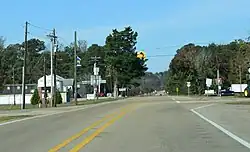
Mississippi Highway 23 (MS 23) is a state highway in Mississippi. The route starts at MS 25 in the town of Smithville. It travels northeastward through the forests of eastern Itawamba County. The highway intersects Interstate 22 (I-22) and U.S. Route 78 (US 78) in Tremont. MS 23 ends at the Mississippi–Alabama state line, just west of Red Bay. The routing that became part of MS 23 was first constructed as a graded road in 1925, from north of Amory to the state line. Gravel was added to sections of the route in the 1930s. The designation was added to maps around 1950, and it was extended to Smithville in 1960. The route was fully paved by 1980.
Recently selected: Atlantic City Expressway • M-6 (Michigan highway) • New York State Route 32
June
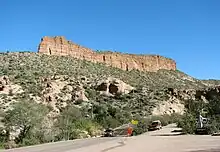
State Route 88 (SR 88) is a 45.67 mi (73.50 km) long state highway in the U.S. state of Arizona. It runs from U.S. Route 60 (US 60) in Apache Junction through desert terrain to SR 188 near Roosevelt Dam. Following the Salt River for much of its length, the section east of Tortilla Flat is known as the Apache Trail and is part of the National Forest Scenic Byway system. The Apache Trail was built in the mid-1920s and the number 88 was assigned in 1927. An eastern extension of SR 88 to Globe was redesignated as SR 188 in the late 1990s.
Recently selected: Mississippi Highway 23 • Atlantic City Expressway • M-6 (Michigan highway)
July
.jpg.webp)
Skyline Drive is a 105-mile (169 km) road that runs the entire length of the National Park Service's Shenandoah National Park in the Blue Ridge Mountains of Virginia, generally along the ridge of the mountains. The drive's northern terminus is at an intersection with U.S. Route 340 (US 340) near Front Royal, and the southern terminus is at an interchange with US 250 near Interstate 64 (I-64) in Rockfish Gap, where the road continues south as the Blue Ridge Parkway. The road has intermediate interchanges with US 211 in Thornton Gap and US 33 in Swift Run Gap. A park entrance fee is charged at the four access points to the drive. Skyline Drive is a two-lane road that has 75 overlooks providing views of the Shenandoah Valley to the west and the Piedmont to the east. The drive provides access to numerous trails, including the Appalachian Trail, and it is also used for biking and horseback riding. Skyline Drive is the main road through Shenandoah National Park and has access to campgrounds, visitor centers, and resorts such as Skyland Resort and Big Meadows. The scenic drive is particularly popular in the fall for leaf peeping when the leaves are changing colors. Skyline Drive is designated a National Scenic Byway and a National Historic Landmark and is listed on the National Register of Historic Places. Plans for the road date back to 1924 when a national park was planned in the Blue Ridge Mountains of Virginia and the main feature was to be a "sky-line drive" providing views of the surrounding land. President Herbert Hoover called for the construction of the road. Groundbreaking for Skyline Drive took place in 1931. The first section, which originally was to run from Rapidan Camp to Skyland, was extended between Swift Run Gap and Thornton Gap and opened in 1934. Skyline Drive was extended north to Front Royal in 1936 and south to Jarman Gap in 1939. The road between Jarman Gap and Rockfish Gap was built as part of the Blue Ridge Parkway in 1939 and was incorporated into Skyline Drive in 1961. The Civilian Conservation Corps played a large part in constructing Skyline Drive.
Recently selected: Arizona State Route 88 • Mississippi Highway 23 • Atlantic City Expressway
August

State Road 930 (SR 930) is an Indiana State Road that runs between Fort Wayne and New Haven in the US state of Indiana. The 12.97 miles (20.87 km) of SR 930 serve as a connection with U.S. Route 30 (US 30) through these two cities between the beginning of the concurrency with Interstate 69 (I-69) in Fort Wayne and the end of its concurrency with I-469 in New Haven. All of the highway is listed on the National Highway System. Various sections are urban two-lane highway, urbanized four-lane divided highway, and urbanized six-lane divided highway. The highway passes through industrial and commercial properties. SR 930 was designated in 1998, and replaced segments of US 30 in Fort Wayne and New Haven that were formerly part of the Lincoln Highway in the 1920s, as well as Coliseum Boulevard, which was designated as part of US 30 in the 1950s.
Recently selected: Skyline Drive • Arizona State Route 88 • Mississippi Highway 23
September

Pennsylvania Route 321 (PA 321) is a 43.8-mile-long (70.5 km) state highway located in Elk and McKean counties in the U.S. state of Pennsylvania, maintained by the Pennsylvania Department of Transportation (PennDOT). The southern terminus is at U.S. Route 219 (US 219) in the community of Wilcox. The northern terminus is at PA 346 within the Allegheny National Forest. PA 321 heads northwest from Wilcox through rural areas to the borough of Kane, where it forms a brief concurrency with US 6. North of here, the route heads through the national forest and runs along the shore of the Allegheny Reservoir. PA 321 runs east briefly with PA 59 before winding north through more forest to its northern terminus. A portion of the route along the Allegheny Reservoir is designated as the Longhouse National Scenic Byway, a Pennsylvania Scenic Byway and National Forest Scenic Byway. The road between Wilcox and Kane was designated as part of PA 6 in 1924. US 119 became concurrent with PA 6 in 1926 before US 219 replaced both designations on this stretch of road two years later. The road between Kane and Kinzua was built in the late 1920s and became an extension of PA 68 in 1935. In 1952, US 219 was relocated off the road between Wilcox and Kane. Plans were made to construct the Kinzua Dam in 1960, and several new roads would need to be built to accommodate the reservoir including a relocation of PA 68. In 1961, the PA 321 designation was approved for the unnumbered road between Wilcox and Kane and PA 68 between Kane and Kinzua in order to provide an access road to the planned recreation area; signs were posted the following year. The PA 321 designation north of Kane was removed in 1966. In the late 1960s, the section between 4 miles (6.4 km) north of Kane and PA 346 was constructed, including a new alignment between Red Bridge and PA 59. Work on the 4-mile (6.4 km) segment north of Kane took place in the early 1970s. In Kane, PA 321 was relocated from following US 6 through the downtown area to use Hacker Street to the east, with reconstruction finished in 1973. The road between Wilcox and Kane, including a bypass of the former, was rebuilt in the mid-1970s. In 1974, PA 321 was extended from US 6 in Kane north to PA 346.
Recently selected: Indiana State Road 930 • Skyline Drive • Arizona State Route 88
October

Interstate 55 (I-55) is a part of the Interstate Highway System that spans 964.25 miles (1,551.81 km) from LaPlace, Louisiana to Chicago, Illinois. Within the state of Louisiana, the highway travels 66 miles (106 km) from the national southern terminus at I-10 in LaPlace to the Mississippi state line north of Kentwood. The route is located in the southeastern portion of Louisiana and parallels the older U.S. Highway 51 (US 51) corridor. While passing through the city of Hammond, I-55 intersects two of the state's major east–west routes, I-12 and US 190. It also serves the smaller city of Ponchatoula, as well as the towns of Amite City and Kentwood. I-55 is a major highway through the New Orleans metropolitan area, the city being located 20 miles (32 km) east of the junction between I-10 and I-55. It also serves as an important hurricane evacuation route for the region. I-55 was opened in several stages beginning in 1960 with a bypass of Ponchatoula and Hammond. The southern 23 miles (37 km) of I-55, consisting of a twin-span viaduct through the Manchac swamp, was completed in 1979 and is one of the longest bridges in the world.
Recently selected: Pennsylvania Route 321 • Indiana State Road 930 • Skyline Drive
November
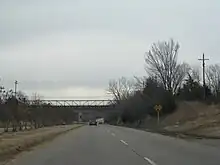
In Oklahoma, U.S. Highway 62 runs diagonally across the state, from the Texas state line in far southwestern Oklahoma to the Arkansas state line near Fayetteville. US-62 spends a total of 402.48 miles (647.73 km) in the Sooner State. The highway passes through fifteen of Oklahoma's counties. Along the way the route serves two of Oklahoma's largest cities, Lawton and Oklahoma City, as well as many regionally important cities, like Altus, Chickasha, Muskogee, and Tahlequah. Despite this, US-62 has no lettered spur routes like many other U.S. routes in Oklahoma do. US-62 has been part of the Oklahoma highway network since 1930. With the advent of the Interstate system, the portion of its route through Oklahoma City was revised several times to adapt to the presence of the new freeways. The present-day route of US-62 includes concurrencies with I-44, I-240, I-35, and I-40.
Recently selected: Interstate 55 in Louisiana • Pennsylvania Route 321 • Indiana State Road 930
December

State Route 520 (SR 520) is a state highway and freeway in the Seattle metropolitan area, part of the U.S. state of Washington. It runs 13 miles (21 km) from Seattle in the west to Redmond in the east. SR 520, a major regional freeway, connects Seattle to the Eastside region of King County via the Evergreen Point Floating Bridge on Lake Washington. SR 520 intersects several state highways, including Interstate 5 (I-5) in Seattle, Interstate 405 (I-405) in Bellevue, and SR 202 in Redmond. The original Evergreen Point Floating Bridge was opened in 1963 as a replacement for the cross-lake ferry system that had operated since the turn of the century. In 1964, SR 520 was designated as a freeway connecting I-5 to I-405. An extension to Redmond was proposed later in the decade. In the 1970s and 1980s, sections of the freeway between Bellevue and Redmond were opened to traffic, replacing the temporary designation of State Route 920 (SR 920). Since the 1990s, SR 520 has been expanded with high-occupancy vehicle lanes (HOV lanes) and new interchanges to serve the Overlake area. In 2016, the original Evergreen Point Floating Bridge was replaced by a wider bridge, as part of a multibillion-dollar expansion program that is scheduled to be completed in the 2020s. The program also includes the construction of new bus infrastructure at Montlake and on the Eastside, as well as a bicycle and pedestrian path along most of the highway's length.
Recently selected: U.S. Route 62 in Oklahoma • Interstate 55 in Louisiana • Pennsylvania Route 321
2018
January
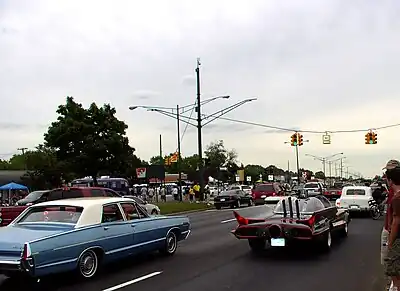
M-1, commonly known as Woodward Avenue, is a north–south state trunkline highway in the Metro Detroit area of the US state of Michigan. The highway, called "Detroit's Main Street", runs from Detroit north-northwesterly to Pontiac. It is one of the five principal avenues of Detroit. These streets were platted in 1805 by Judge Augustus B. Woodward, namesake to Woodward Avenue. The Federal Highway Administration (FHWA) has listed the highway as the Automotive Heritage Trail, an All-American Road in the National Scenic Byways Program. It has also been designated a Pure Michigan Byway by the Michigan Department of Transportation (MDOT), and was also included in the MotorCities National Heritage Area designated by the US Congress in 1998. The trunkline is the dividing line between Detroit's East and West sides, and connects to some of the city's major freeways like Interstate 94 (I-94, Edsel Ford Freeway) and M-8 (Davison Freeway). Woodward Avenue exits Detroit at M-102 (8 Mile Road) and runs through the city's northern suburbs in Oakland County on its way to Pontiac. In between, Woodward Avenue passes through several historic districts in Detroit and provides access to many businesses in the area. The name Woodward Avenue has become synonymous with Detroit, cruising culture and the automotive industry. Woodward Avenue was created after the Detroit Fire of 1805. The thoroughfare followed the route of the Saginaw Trail, an Indian trail that linked Detroit with Pontiac, Flint, and Saginaw. In the age of the auto trails, Woodward Avenue was part of the Theodore Roosevelt International Highway that connected Portland, Maine, with Portland, Oregon, through Ontario in Canada. It was also part of the Dixie Highway, which connected Michigan with Florida. When Michigan created the State Trunkline Highway System in 1913, the roadway was included, numbered as part of M-10 in 1919. Later, it was part of US Highway 10 (US 10) following the creation of the United States Numbered Highway System. Since 1970, it has borne the M-1 designation.
Recently selected: Washington State Route 520 • U.S. Route 62 in Oklahoma • Interstate 55 in Louisiana
February
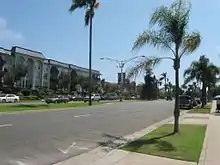
State Route 75 (SR 75) is a short, 13-mile (21 km) expressway in San Diego County, California. It is a loop route of Interstate 5 (I-5) that begins near Imperial Beach, heading west on Palm Avenue. The route continues north along the Silver Strand, a thin strip of land, through Silver Strand State Beach. SR 75 passes through the city of Coronado as Orange Avenue and continues onto the San Diego–Coronado Bay Bridge, which traverses the San Diego Bay, before joining back with I-5 near downtown San Diego at a freeway interchange. The Silver Strand Highway was constructed and open to the public by 1924. What would become SR 75 was added to the state highway system in 1933, and designated Legislative Route 199 in 1935. SR 75 was not officially designated until the 1964 state highway renumbering. The Coronado Bay Bridge opened in 1969, and provided a direct connection between San Diego and Coronado. Since then, various proposals have taken place to relieve commuter traffic between San Diego and Naval Air Station North Island that traverses the city of Coronado. However, none of these proposals have gained support, including an attempt in 2010.
Recently selected: M-1 (Michigan highway) • Washington State Route 520 • U.S. Route 62 in Oklahoma
March

New York State Route 308 (NY 308) is a short state highway, 6.19 miles (9.96 km) in length, located entirely in northern Dutchess County, in the U.S. state of New York. It is a major collector road through mostly rural areas that serves primarily as a shortcut for traffic from the two main north–south routes in the area, U.S. Route 9 (US 9) and NY 9G, to get to NY 199 and the Taconic State Parkway. The western end of NY 308 is located within the Rhinebeck Village Historic District, a 2.6-square-mile (6.7 km2) historic district comprising 272 historical structures. The highway passes near the Dutchess County Fairgrounds, several historical landmarks, and the Landsman Kill. Indicated by artifacts found near Lake Sepasco, a small lake along NY 308, the highway began its history in about 1685, when a group of Native Americans called the Sepasco built the Sepasco Trail; this trail ran from the Hudson River, eastward through modern-day Rhinebeck (then Sepasco or Sepascoot), and ended at Lake Sepasco, following roughly Route 308 and its side roads. The trail remained until 1802, when part of the Ulster and Delaware Turnpike — also known as the Salisbury Turnpike — was chartered over the trail and extended from Salisbury, Connecticut to the Susquehanna River at or near the Town of Jericho (now Bainbridge). Route 308 was designated as part of the 1930 renumbering of New York state highways, incorporating a portion of the former Ulster and Delaware Turnpike. The route originally extended from Milan westward to Rhinecliff to serve a ferry landing on the Hudson River. It was truncated to US 9 in the 1960s but its former routing to Rhinecliff is still state-maintained as an unsigned reference route. The highway was also intended to be part of the then-new Kingston–Rhinecliff Bridge until plans were changed to involve other routes and the building site for the bridge was moved about 3 miles (5 km) northward.
Recently selected: California State Route 75 • M-1 (Michigan highway) • Washington State Route 520
April
.jpg.webp)
U.S. Highway 75 (US 75) is a United States Highway in northwestern Iowa. It begins at the Missouri River on a bridge with Interstate 129 (I-129) and US 20. Immediately upon landing in Iowa from Nebraska, I-129 ends at an interchange with I-29. US 20 and US 75 continue around Sioux City on a four-lane expressway until US 20 exits to the east. US 75 heads to the north-northeast, parallel to the Floyd River, until Le Mars. There, Iowa Highway 60 (Iowa 60) continues northeastward on the expressway while US 75 heads due north. Near Hull, it is briefly overlapped by US 18. It leaves the state and enters Minnesota north of Rock Rapids. US 75 was one of the original U.S. Highways to be created in 1926, though its roots trace back nine years prior to the creation of the King of Trails, a 2,000-mile-long (3,200 km) auto trail that connected Winnipeg, Manitoba, and Galveston, Texas. In the Upper Midwest, there were two branches of the King of Trails that converged at Sioux City, which then continued south to Council Bluffs. In 1920, the Iowa State Highway Commission assigned route numbers to roads in order to improve wayfinding for travelers. The King of Trails was assigned Primary Road No. 12 (No. 12) from Council Bluffs to Sioux City and the western branch and No. 22 along the eastern branch. In 1926, the U.S. Highway 75 name was applied through Iowa to Primary Roads No. 12 and 22, the King of Trails route. In the 1950s, US 75's importance began to wane as I-29 was built along the Missouri River. As sections of the Interstate Highway opened up between Council Bluffs and Sioux City, US 75 were rerouted onto the new road. In 1984, the southern half of US 75 was removed from Iowa and rerouted into Nebraska. Today, the highway is still an important part of Iowa's highway system. In the late 1990s and throughout the 2000s, the highway along with Iowa 60 were improved into a continuous four-lane expressway between Sioux City and Minnesota.
Recently selected: New York State Route 308 • California State Route 75 • M-1 (Michigan highway)
May and June
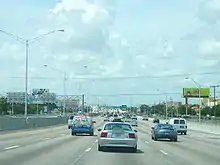
State Road 826 (SR 826) is a bypass route around the greater Miami area, traveling approximately 30 miles (48 km) in a northeasterly arc from U.S. Route 1 (US 1) in Pinecrest to its terminus at State Road A1A in Sunny Isles Beach. Between its southern terminus and the Golden Glades Interchange, State Road 826 is known as the Palmetto Expressway, a heavily traveled freeway with portions of the road carrying in excess of 250,000 vehicles a day. Unlike many of the other expressways in Miami-Dade County, the Palmetto Expressway is untolled. East of the interchange, State Road 826 is a surface road connecting North Miami and North Miami Beach to Sunny Isles Beach over the Intracoastal Waterway.
Recently selected: U.S. Route 75 in Iowa • New York State Route 308 • California State Route 75
July
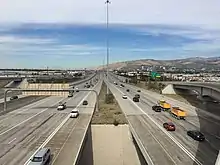
Interstate 80 (I-80) is a part of the Interstate Highway System that runs from San Francisco, California, to Teaneck, New Jersey. The portion of the highway in the U.S. state of Utah is 196.35-mile-long (315.99 km), through the northern part of the state. From west to east, I-80 crosses the state line from Nevada in Tooele County and traverses the Bonneville Salt Flats—which are a part of the larger Great Salt Lake Desert. It continues alongside the Wendover Cut-off—the corridor of the former Victory Highway—U.S. Route 40 (US-40) and the Western Pacific Railroad Feather River Route. After passing the Oquirrh Mountains, I-80 enters the Salt Lake Valley and Salt Lake County. A short portion of the freeway is concurrent with I-15 through Downtown Salt Lake City. At the Spaghetti Bowl, I-80 turns east again into the mouth of Parley's Canyon and Summit County, travels through the mountain range and intersects the eastern end of I-84 near Echo Reservoir before turning northeast towards the Wyoming border near Evanston. I-80 was built along the corridor of the Lincoln Highway and the Mormon Trail through the Wasatch Range. The easternmost section also follows the historical routes of the First Transcontinental Railroad and US-30S. Construction of the controlled-access highway began in the 1950s, and by the late 1970s most of the freeway across the state of Utah had been completed. The four-and-a-half-mile-long (7.2 km) section of I-80 between Utah State Route 68 (SR-68, Redwood Road) and the Salt Lake City International Airport was the last piece of the nearly 2,900-mile-long (4,700 km) freeway to be completed. It was opened on August 22, 1986, and was about 50 miles (80 km) from the site of another cross-country milestone in Utah, the driving of the Golden Spike of the First Transcontinental Railroad at Promontory Summit.
Recently selected: Florida State Road 826 • U.S. Route 75 in Iowa • New York State Route 308
August
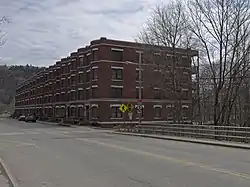
Vermont Route 44 (VT 44) is a state highway in the U.S. state of Vermont. The highway runs 10.190 miles (16.399 km) from VT 106 in Reading east to U.S. Route 5 (US 5) and VT 12 in Windsor. VT 44 passes through West Windsor in southern Windsor County, serving the area north of Mount Ascutney. The highway has an auxiliary route, VT 44A, which provides access to Mount Ascutney State Park and connects VT 44 with Interstate 91 (I-91) in Weathersfield. VT 44 was established in 1958 along the highway between Reading and Windsor. The three towns had previously maintained the highway with support from the state for construction and maintenance, including reconstruction along several segments in the 1940s. The state paved VT 44 in the early 1970s and early 1980s. VT 44A was established in 1987 when part of VT 44 in Windsor was returned to town maintenance.
Recently selected: Interstate 80 in Utah • Florida State Road 826 • U.S. Route 75 in Iowa
September
.jpg.webp)
Montana Highway 287 (MT 287) is a state highway in the U.S. state of Montana. The highway runs 42.822 miles (68.915 km) from MT 41 in Twin Bridges east to U.S. Route 287 (US 287) in Ennis. MT 287 is the primary east–west highway of Madison County. The highway connects the county's four towns, including Sheridan and the county seat of Virginia City. The course of MT 287 follows the ultimate portions of two trails that met in Virginia City, the center of the Alder Gulch gold rush of the mid-1860s and the second territorial capital of Montana. Parts of the highway were improved from rudimentary roads around 1920 from Virginia City to Ennis. This connection became the first portion of Montana Highway 34 in the early 1930s; the highway was extended west to Twin Bridges in the late 1930s. MT 34 was reconstructed from Twin Bridges through Alder to Virginia City in the late 1930s and early 1940s and between Virginia City and Ennis in the late 1940s to mid-1950s. The MT 287 designation was first applied to a cross-state route from West Yellowstone to Canada in the late 1950s. The highway was rerouted in place of MT 34 in the early 1960s. MT 287 was replaced by US 287 along much of the cross-state corridor in the mid-1960s. The highway extended north of Twin Bridges to Whitehall until the late 1970s, when it achieved its current length.
Recently selected: Vermont Route 44 • Interstate 80 in Utah • Florida State Road 826
October
_at_Stubbs_Road_(Jefferson_County_Route_48-3)_in_Kearneysville%252C_Jefferson_County%252C_West_Virginia.jpg.webp)
West Virginia Route 480 (WV 480) is a 5.64-mile-long (9.08 km) state highway in the U.S. state of West Virginia. Known for most of its length as Kearneysville Pike, the highway extends from WV 115 in Kearneysville north to the Maryland state line at the Potomac River in Shepherdstown, from where the highway continues as Maryland Route 34 (MD 34). The route is one of the main north–south highways of northern Jefferson County and passes through the campus of Shepherd University. WV 480 was originally established in the early 1920s as West Virginia Route 48. The highway was paved in the mid-1920s, which included a different routing through Shepherdstown. WV 48's present routing through the town was established in the late 1930s when the first James Rumsey Bridge was completed; that bridge was replaced with the current bridge in the mid-2000s. WV 48 was renumbered to WV 480 in the mid-1970s after U.S. Route 48 (US 48) was established in West Virginia and Maryland.
Recently selected: Montana Highway 287 • Vermont Route 44 • Interstate 80 in Utah
November
_in_Lake_City%252C_Seattle_-_01.jpg.webp)
State Route 522 (SR 522) is a state highway in the U.S. state of Washington, serving the Seattle metropolitan area. The highway connects the city of Seattle to the northeastern suburbs of Kenmore, Bothell, Woodinville, and Monroe, traveling approximately 25 miles (40 km). Its western half is primarily an arterial street, named Lake City Way and Bothell Way, following the northern shore of Lake Washington; the eastern half is a grade-separated freeway that runs between Woodinville and Monroe. SR 522 connects several of the metropolitan area's major highways, including Interstate 5 (I-5), I-405, SR 9, and U.S. Route 2 (US 2). The present day route of SR 522 was built in stages between 1907 and 1965, beginning with the "Red Brick Road" from Seattle to Bothell, then part of the Pacific Highway and later US 99. The road later became a branch of Primary State Highway 2 (PSH 2) in 1937, and was extended east to Redmond and North Bend. A branch of the Stevens Pass Highway was built to connect PSH 2 in Bothell and Monroe in 1965, and was incorporated into SR 202 after it was designated in 1964. The Bothell–Monroe highway was re-designated as part of SR 522 in 1970, leaving SR 202 on the Bothell–North Bend highway. Since the late 1990s, the SR 522 corridor between Woodinville and Monroe has been partially converted to a freeway to address safety concerns and a growing population.
Recently selected: West Virginia Route 480 • Montana Highway 287 • Vermont Route 44
December
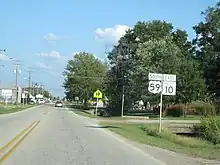
U.S. Highway 59 (US-59) heads along the eastern portion of the state of Oklahoma. US-59's 216.47-mile (348.37 km) route through Oklahoma takes it through the mountainous terrain of the eastern Oklahoma Ouachitas and Ozarks. US-59 serves several lakes and towns through Oklahoma's Green Country, including Grand Lake, a major recreation center. The route enters the state from Arkansas near Fogel, Arkansas, and ends at the Kansas state line south of Chetopa, Kansas. US-59 was first designated in Oklahoma around 1935. The highway's route at that time was largely the same as it is today; however, between the Afton area and Welch, US-59 passed through Vinita instead following the modern-day route passing east of it. US-59 was changed to follow the present-day route in 1951. Since then, US-59 has undergone only minor adjustments, many of which eliminated curves and provided a more direct route for travelers using the highway to traverse eastern Oklahoma.
Recently selected: Washington State Route 522 • West Virginia Route 480 • Montana Highway 287
2019
January
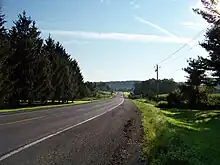
New York State Route 175 (NY 175) is a west–east state highway located in Onondaga County, New York, in the United States. The 15.46-mile (24.88 km) route begins at an intersection with U.S. Route 20 (US 20) east of the village of Skaneateles and passes through the village of Marcellus before ending at a junction with US 11 in Syracuse. The highway was designated in the 1930 renumbering of state highways in New York. The section of NY 175 from the town of Marcellus to the end of the NY 173 concurrency is part of the Seneca Turnpike, which was established in 1800 and dissolved in 1852. This portion of the Seneca Turnpike was instrumental in the development of the villages of Skaneateles and Marcellus. When designated in 1930, NY 175 was on a rural stretch of highway connecting Marcellus to Onondaga, and brought about an increase in population and development along its route.
Recently selected: U.S. Route 59 in Oklahoma • Washington State Route 522 • West Virginia Route 480
February

State Route 99 (SR 99), also known as the Pacific Highway, is a state highway in the Seattle metropolitan area, part of the U.S. state of Washington. It runs 49 miles (79 km) from Fife in the south to Everett in the north, passing through the cities of Federal Way, SeaTac, Seattle, Shoreline, and Lynnwood. The route primarily follows arterial streets that once formed part of U.S. Route 99 (US 99) but has several freeway segments, including the SR 99 Tunnel in Downtown Seattle. US 99 was created in 1926 and replaced earlier local roads that date back to the 1890s and state roads designated as early as 1913. The highway was moved onto the Alaskan Way Viaduct in 1953, replacing a congested stretch through Downtown Seattle, and other sections were built to expressway standards in the 1950s. US 99 was ultimately replaced by the Tacoma–Everett section of Interstate 5 (I-5), which opened in stages between 1965 and 1969. After decades of rampant crime on some sections of SR 99, created to keep sections of the highway under state control, various city governments funded projects to beautify the highway and convert it into a boulevard. The Alaskan Way Viaduct was closed on January 11, 2019, and is planned to be replaced with a downtown bored tunnel that is scheduled to open on February 4, 2019. The $3 billion replacement project was spurred by the 2001 Nisqually earthquake, which damaged the viaduct and left it vulnerable to further damage, as well as city plans to revitalize the Seattle waterfront, but was mired in planning delays for several years before construction began in 2013 using Bertha, the world's largest tunnel boring machine.
Recently selected: New York State Route 175 • U.S. Route 59 in Oklahoma • Washington State Route 522
March

M-553 is a north–south state trunkline highway in Marquette County. It is the main highway connection between M-35 near Gwinn and the expressway segment of US 41/M-28 in Marquette. In between, the highway runs to the west of the Sawyer International Airport on the site of a former US Air Force base, in the Sands Plains area. The intersection with CR 480, known locally as the Crossroads, is the site of several businesses. North of this location, M-553 runs through some hilly terrain around a local ski hill. The trunkline was originally CR 553, which dates back to the 1930s and was fully paved in the 1940s; a segment was relocated in the 1950s. The county road was transferred by the Marquette County Road Commission to MDOT jurisdiction in 1998. MDOT assigned most of the former county road the M-553 designation after the transfer was complete. One section that was less than a mile (about 1.3 km) was given the M-554 designation. This trunkline was unsigned by the state. In 2005, control of various roadways was exchanged between the City of Marquette and MDOT, and M-553 was extended through the city. At the same time, M-554 was turned over to the city's jurisdiction.
Recently selected: Washington State Route 99 • New York State Route 175 • U.S. Route 59 in Oklahoma
April
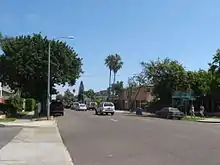
State Route 282 (SR 282) is an east–west state highway entirely within the city of Coronado, California. It is a spur of SR 75 and connects the rest of the state highway system with Naval Air Station North Island. The road is part of a link connecting to the metropolitan area of San Diego via SR 75 and the Coronado Bay Bridge. The entire route uses a one-way couplet, with Third Street in the westbound direction and Fourth Street in the eastbound direction. Third and Fourth streets, as part of the Coronado street system, have existed since the 19th century, and were paved in the early 20th century. SR 282 was designated in 1968, around the time the San Diego–Coronado Bridge was opened. Attempts to build first a highway, and later a tunnel, to allow base traffic to bypass the Coronado city streets, were rejected by voters in 1974 and 2010, respectively.
Recently selected: M-553 (Michigan highway) • Washington State Route 99 • New York State Route 175
May
_at_Maryland_State_Route_501_(Chillum_Road)_in_Mount_Rainier%252C_Prince_Georges_County%252C_Maryland.jpg.webp)
Maryland Route 500 (MD 500) is a state highway in the U.S. state of Maryland. Known as Queens Chapel Road, the highway runs 2.22 miles (3.57 km) from Michigan Avenue at the District of Columbia boundary in Avondale north to MD 410 in Hyattsville. MD 500 connects Washington with the Prince George's County cities of Mount Rainier and Hyattsville. The state highway also connects those communities with a pair of stations on the Green Line of the Washington Metro. Queens Chapel Road was constructed as the original MD 210 from Washington to Hyattsville in the 1910s. MD 500 was built from Hyattsville through University Park to U.S. Route 1 (US 1) in the early 1930s. MD 500 assumed the course of MD 210 in the mid-1940s. The highway was relocated in West Hyattsville and expanded to a divided highway toward Washington in the early 1950s. MD 500 was truncated at MD 410 when University Park took over the highway prior to the construction of the Metro Green Line through the town in the late 1980s.
Recently selected: California State Route 282 • M-553 (Michigan highway) • Washington State Route 99
June

U.S. Route 163 (US 163) is a 64-mile (103 km) U.S. Highway that runs from US 160 northward to US 191 in the U.S. states of Arizona and Utah. The southernmost 44 miles (71 km) of its length are within the Navajo Nation. The highway forms part of the Trail of the Ancients, a National Scenic Byway. The highway cuts through the heart of Monument Valley and has been featured in numerous movies and commercials. The highway was designated in 1970, replacing Arizona State Route 464 and Utah State Route 47 as well as a portion of the old alignment of US 160 in Utah. In 1981, US 191 was routed over the northern section of US 163, effectively truncating the northern terminus to Bluff, Utah from Crescent Junction. The state of Utah briefly had plans for a different routing of US 163 north of Bluff. These plans were rejected, resulting in discrepancies between the signed route and the official designation by the American Association of State Highway and Transportation Officials that were not resolved until 2008. The route number does not follow the numbering convention for U.S. highways, as the number 163 would normally be used for a spur of U.S. Route 63; however, these two highways have never connected.
Recently selected: Maryland Route 500 • California State Route 282 • M-553 (Michigan highway)
July
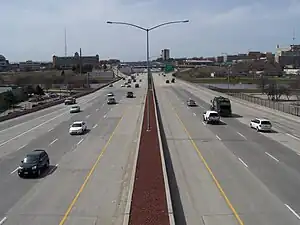
Interstate 235 (I-235) in Iowa is an auxiliary Interstate Highway that runs just north of downtown Des Moines through the heart of the Des Moines metropolitan area. I-235 runs from the junction of Interstate 35 and Interstate 80 in West Des Moines to the separation of the same two interstates in Ankeny. The highway is approximately 14 miles (23 km) long. I-235, which had seen little improvement since its construction in the 1960s, was completely rebuilt and widened in a project that spanned most of the 2000s. Prior to the reconstruction, I-235 had two lanes in each direction with a third lane near downtown; the entire route now has at least three lanes of traffic in each direction, with an additional one or two lanes closer to the heart of the city.
Recently selected: U.S. Route 163 • Maryland Route 500 • California State Route 282
August
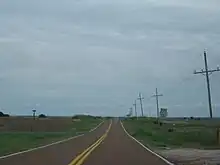
State Highway 132, also known as SH-132, is a state highway in north-central Oklahoma. It connects State Highway 51 west of Hennessey to the Kansas state line near Manchester, and is 65.3 miles (105.1 km) long. It has no lettered spur routes. SH-132 was originally added to the state highway system in 1956, when it ran between Carrier and U.S. Route 64 (US-64) east of Nash. It was extended further northward to the Kansas state line in 1958, and southward, to its current southern terminus, in 1962.
Recently selected: Interstate 235 (Iowa) • U.S. Route 163 • Maryland Route 500
September
.jpg.webp)
Interstate 469 (I-469) is an Interstate Highway in northeastern Indiana. It is an auxiliary route of parent I-69 that also carries portions of US Highway 24 (US 24), US 30, and US 33 around the urban parts of Fort Wayne. It is 30.83 miles (49.62 km) in length. The Interstate was originally conceived as a bypass for US 24 around the south and east ends of Fort Wayne. Due to heavy traffic on US 30 through the city, support was gained to connect the bypass to I-69 on the city's north end. I-469 was given the name Ronald Reagan Expressway in 2005. I-469 was the most expensive civic project in the history of Allen County, costing over $207 million. As a bypass route, I-469 has been ineffective at helping with north–south traffic along I-69. However, the route has served effectively as an east–west bypass around the city, removing heavy truck traffic from passing through Fort Wayne.
Recently selected: Oklahoma State Highway 132 • Interstate 235 (Iowa) • U.S. Route 163
October and November

Interstate 495 (I-495) is a 11.47-mile (18.46 km) long Interstate highway in the U.S. state of Delaware. The highway serves as a six-lane bypass of I-95 around the city of Wilmington. I-495 begins at an interchange with I-95 and I-295 near Newport to the southwest of Wilmington. From here, the road heads east to the Port of Wilmington, where it turns northeast and crosses the Christina River as it heads to the east of downtown Wilmington. Upon reaching Edgemoor, I-495 runs between the Delaware River to the east and U.S. Route 13 (US 13) to the west, continuing to Claymont. In Claymont, I-495 turns north and merges into northbound I-95 at an interchange with Delaware Route 92 (DE 92) just south of the Pennsylvania state line. Plans for a bypass of Wilmington to the east date back to 1948 and was incorporated into the Interstate Highway System in 1956. This interstate bypass was numbered I-495 in the 1960s. Construction on building I-495 took place during the course of the 1970s, with the entire length of the highway completed and opened to traffic in 1977. Between 1978 and 1980, I-95 was designated along the I-495 alignment while the South Wilmington Viaduct along I-95 was reconstructed; during this time the route through Wilmington was known as I-895. The US 13/DE 3 interchange in Edgemoor opened in 1988. In 2014, the bridge over the Christina River was closed due to tilting support columns until repairs were completed.
Recently selected: Interstate 469 • Oklahoma State Highway 132 • Interstate 235 (Iowa)
December
_in_Germany_Township%252C_Adams_County%252C_Pennsylvania.jpg.webp)
Pennsylvania Route 97 (PA 97) is a state highway in the U.S. state of Pennsylvania. Known for most of its length as Baltimore Pike, the highway runs 9.363 miles (15.068 km) from the Maryland state line near Littlestown, where the highway continues as Maryland Route 97 (MD 97), northwest to U.S. Route 15 (US 15) near Gettysburg. PA 97 connects Gettysburg and Littlestown in southeastern Adams County. The highway also links those communities with Westminster and Baltimore. From PA 97's northern end, Baltimore Pike continues toward Gettysburg as State Route 2035 (SR 2035) through the Gettysburg Battlefield Historic District, where it provides access to the Gettysburg Museum and Visitor Center. Baltimore Pike was built as a turnpike in the early 19th century to connect Gettysburg, Littlestown, and Baltimore. The turnpike was a prominent linear feature during the 1863 Battle of Gettysburg despite not being the focus of a particular skirmish. Baltimore Pike was designated one of the original legislative routes in the early 1910s and became the northernmost part of US 140 in the late 1920s. The U.S. Highway was widened and resurfaced in the 1940s. When the US 140 designation was retired in the late 1970s, the highway became PA 97 to match the adjacent Maryland highway. With the creation of PA 97, the route had its northern terminus at the US 15 interchange while Baltimore Pike north of there became unnumbered.
Recently selected: Interstate 495 (Delaware) • Interstate 469 • Oklahoma State Highway 132
2020
January
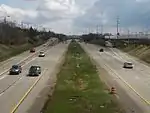
Interstate 496 (I-496) is an auxiliary Interstate Highway that passes through downtown Lansing. The loop route runs east from I-96 to the downtown area, turning south concurrently with US 127. It passes a former assembly plant used by Oldsmobile and runs along or crosses parts of the Grand and Red Cedar rivers. Construction started in 1963, and the freeway opened on December 18, 1970. Segments south of downtown were built near a historically black neighborhood that dates from the early 20th century. Community leaders opted not to fight the construction of the freeway, instead seeking affordable housing and relocation assistance for displaced residents. The city named the freeway in honor of a former mayor when it opened in 1970, but the local historical society proposed that the state rename it after Ransom E. Olds, the founder of Oldsmobile and the REO Motor Car Company, after his mansion was demolished to make way for the freeway. The Michigan Legislature approved the name "Olds Freeway" two years later.
Recently selected: Pennsylvania Route 97 (Adams County) • Interstate 495 (Delaware) • Interstate 469
February
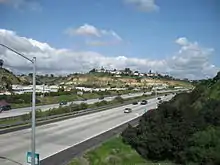
State Route 54 (SR 54) is a state highway in the U.S. state of California that consists of two segments in San Diego County. The westernmost part of the highway is known as the South Bay Freeway, beginning at Interstate 5 (I-5) in National City and running along the Sweetwater River before ending at the intersection with SR 125 and Jamacha Boulevard near Spring Valley. SR 54 then resumes at SR 94 in Rancho San Diego as an undivided highway that leads to the city limits of El Cajon. County Route S17 (CR S17) connects the two portions of the highway; the center portion of SR 54 was never constructed. The first section of the freeway opened in 1963, east of I-805. The extension of the freeway west to I-5 was delayed to coincide with the construction of the Sweetwater River flood channel. While construction started in 1984, a court stopped the process for a few years, and this portion was not complete until 1992. The final section of freeway, which was upgraded from an expressway, opened in 2007, to coincide with the extension of SR 125 south to Otay Mesa.
Recently selected: Interstate 496 • Pennsylvania Route 97 (Adams County) • Interstate 495 (Delaware)
March

New York State Route 373 (NY 373) is a short state highway in Essex County, New York, within Adirondack Park. It begins at U.S. Route 9 (US 9) and proceeds eastward, ending at a ferry landing on Lake Champlain. It intersects two county routes, several local roads, and a reference route—NY 912T—which connects it with US 9. NY 373 is the only connector between US 9 and the hamlet of Port Kent and the ferry that serves it. The hamlet of Port Kent and the connecting road were originally built in 1823. The village was planned to act as a source of labor for iron manufacturing and to provide for the industrial needs of Essex County. The hamlet grew and eventually became connected to Burlington, Vermont, via an hour-long ferry across Lake Champlain. The road that accessed Port Kent originally began in Keeseville, but became part of the longer Port Kent and Hopkinton Turnpike in the 1830s. The highway that is now NY 373 was also designated as part of the Theodore Roosevelt International Highway in 1919. When NY 373 was designated in 1930, a small portion of it was maintained by the town of Chesterfield. This section was turned over to the State of New York during a maintenance swap with Essex County in 1985.
Recently selected: California State Route 54 • Interstate 496 • Pennsylvania Route 97 (Adams County)
April

Interstate 82 (I-82) is an Interstate Highway in the Pacific Northwest region of the United States that travels through parts of Washington and Oregon. It runs 144 miles (232 km) from its northwestern terminus at I-90 in Ellensburg, Washington, to its southeastern terminus at I-84 in Hermiston, Oregon. The highway passes through Yakima and the Tri-Cities. I-82 travels concurrently with U.S. Route 97 (US 97) between Ellensburg and Union Gap; US 12 from Yakima to the Tri-Cities; and US 395 from Kennewick and Umatilla, Oregon. I-82 primarily serves the Yakima Valley agricultural region, following the Yakima and Columbia rivers southeastward to the Tri-Cities. The highway enters the valley from the north by crossing the Manastash Ridge, which separates Yakima from the Kittitas Valley. I-82 bypasses the Tri-Cities by traveling southwest around Richland and Kennewick, turning south to cross the Columbia River on the Umatilla Bridge. The I-82 corridor was originally used by several state and national highways, including the Inland Empire Highway and US 410, which were built in the early 20th century. The federal government created I-82 in late 1957 to serve military facilities in the region. The first section of I-82 to be constructed was the easterly bypass of Yakima, which opened in 1963 and was gradually extended north to Ellensburg by 1971. The Yakima Valley section, connecting Union Gap to Prosser, was constructed between 1977 and 1982. The routing of the highway between Prosser and I-84 was very controversial with residents of the Tri-Cities area, who lobbied for a longer I-82 alignment to serve them. Oregon legislators and highway officials remained opposed to a routing that bypassed Umatilla, leading to several attempts at finding a compromise along the Wallula Gap or in other areas southeast of the Tri-Cities. In 1973, Oregon and Washington adopted a federal compromise to build I-82 through Umatilla and around the outskirts of the Tri-Cities with a spur route (I-182) to serve the area directly. The Tri-Cities section opened in 1986 while in Oregon, the final section of I-82 was completed in 1988.
Recently selected: New York State Route 373 • California State Route 54 • Interstate 496
August

Interstate 80 traverses the northern portion of the U.S. state of Nevada. The freeway serves the Reno–Sparks metropolitan area and passes through the towns of Fernley, Lovelock, Winnemucca, Battle Mountain, Carlin, Elko, Wells and West Wendover on its way through the state.
I-80 follows the historical routes of the California Trail, First Transcontinental Railroad and Feather River Route throughout portions of Nevada. Throughout the entire state, I-80 follows the historical routes of the Victory Highway, State Route 1 and U.S. Route 40 (US 40). The freeway corridor follows the paths of the Truckee and Humboldt Rivers. These rivers have been used as a transportation corridor since the California Gold Rush of the 1840s.
Recently selected:Interstate 82 • New York State Route 373 • California State Route 54
